PPDI5039 Project/Placement Design and Implementation
VerifiedAdded on 2021/09/15
|16
|5743
|70
AI Summary
Contribute Materials
Your contribution can guide someone’s learning journey. Share your
documents today.
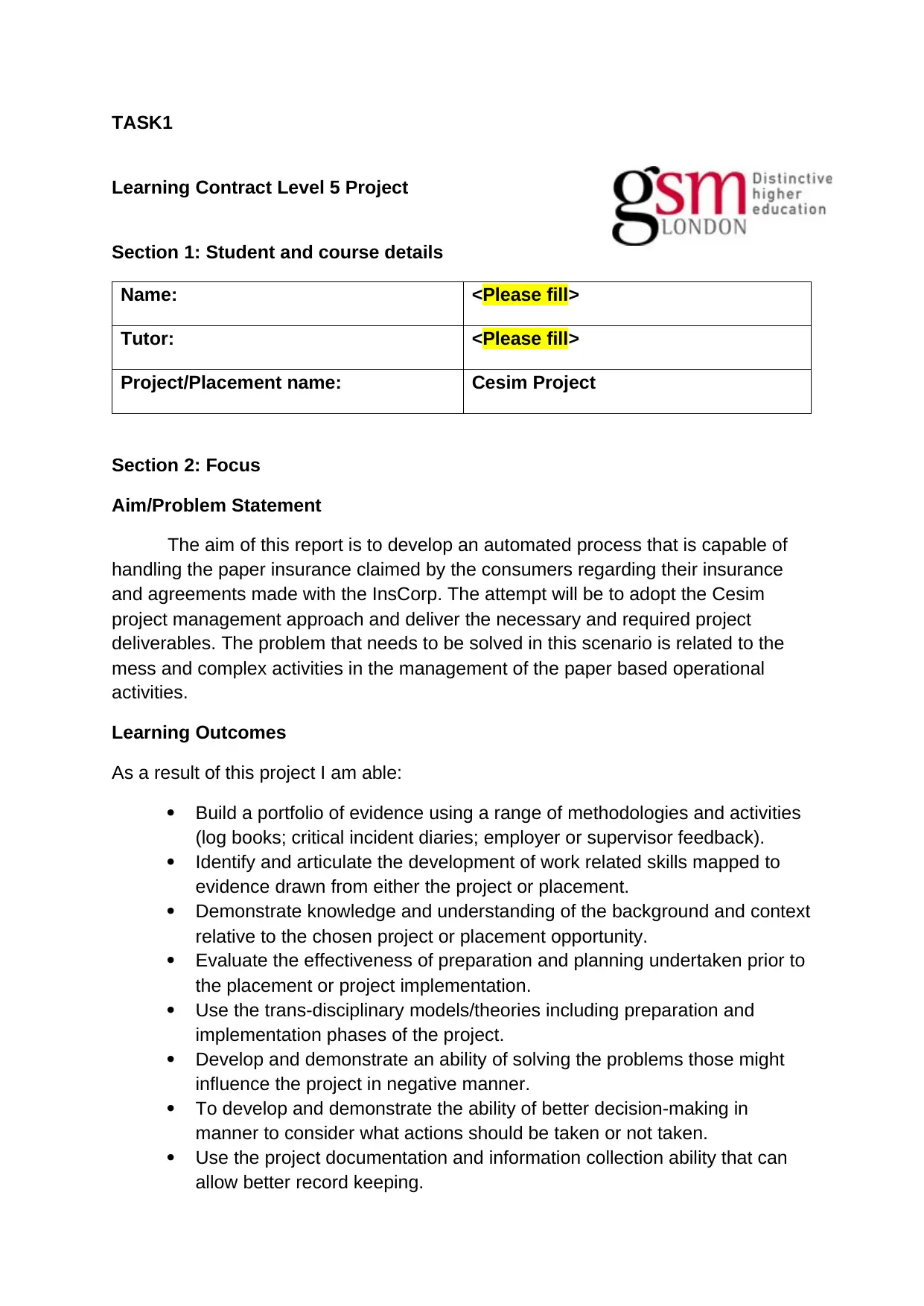
TASK1
Learning Contract Level 5 Project
Section 1: Student and course details
Name: <Please fill>
Tutor: <Please fill>
Project/Placement name: Cesim Project
Section 2: Focus
Aim/Problem Statement
The aim of this report is to develop an automated process that is capable of
handling the paper insurance claimed by the consumers regarding their insurance
and agreements made with the InsCorp. The attempt will be to adopt the Cesim
project management approach and deliver the necessary and required project
deliverables. The problem that needs to be solved in this scenario is related to the
mess and complex activities in the management of the paper based operational
activities.
Learning Outcomes
As a result of this project I am able:
Build a portfolio of evidence using a range of methodologies and activities
(log books; critical incident diaries; employer or supervisor feedback).
Identify and articulate the development of work related skills mapped to
evidence drawn from either the project or placement.
Demonstrate knowledge and understanding of the background and context
relative to the chosen project or placement opportunity.
Evaluate the effectiveness of preparation and planning undertaken prior to
the placement or project implementation.
Use the trans-disciplinary models/theories including preparation and
implementation phases of the project.
Develop and demonstrate an ability of solving the problems those might
influence the project in negative manner.
To develop and demonstrate the ability of better decision-making in
manner to consider what actions should be taken or not taken.
Use the project documentation and information collection ability that can
allow better record keeping.
Learning Contract Level 5 Project
Section 1: Student and course details
Name: <Please fill>
Tutor: <Please fill>
Project/Placement name: Cesim Project
Section 2: Focus
Aim/Problem Statement
The aim of this report is to develop an automated process that is capable of
handling the paper insurance claimed by the consumers regarding their insurance
and agreements made with the InsCorp. The attempt will be to adopt the Cesim
project management approach and deliver the necessary and required project
deliverables. The problem that needs to be solved in this scenario is related to the
mess and complex activities in the management of the paper based operational
activities.
Learning Outcomes
As a result of this project I am able:
Build a portfolio of evidence using a range of methodologies and activities
(log books; critical incident diaries; employer or supervisor feedback).
Identify and articulate the development of work related skills mapped to
evidence drawn from either the project or placement.
Demonstrate knowledge and understanding of the background and context
relative to the chosen project or placement opportunity.
Evaluate the effectiveness of preparation and planning undertaken prior to
the placement or project implementation.
Use the trans-disciplinary models/theories including preparation and
implementation phases of the project.
Develop and demonstrate an ability of solving the problems those might
influence the project in negative manner.
To develop and demonstrate the ability of better decision-making in
manner to consider what actions should be taken or not taken.
Use the project documentation and information collection ability that can
allow better record keeping.
Secure Best Marks with AI Grader
Need help grading? Try our AI Grader for instant feedback on your assignments.
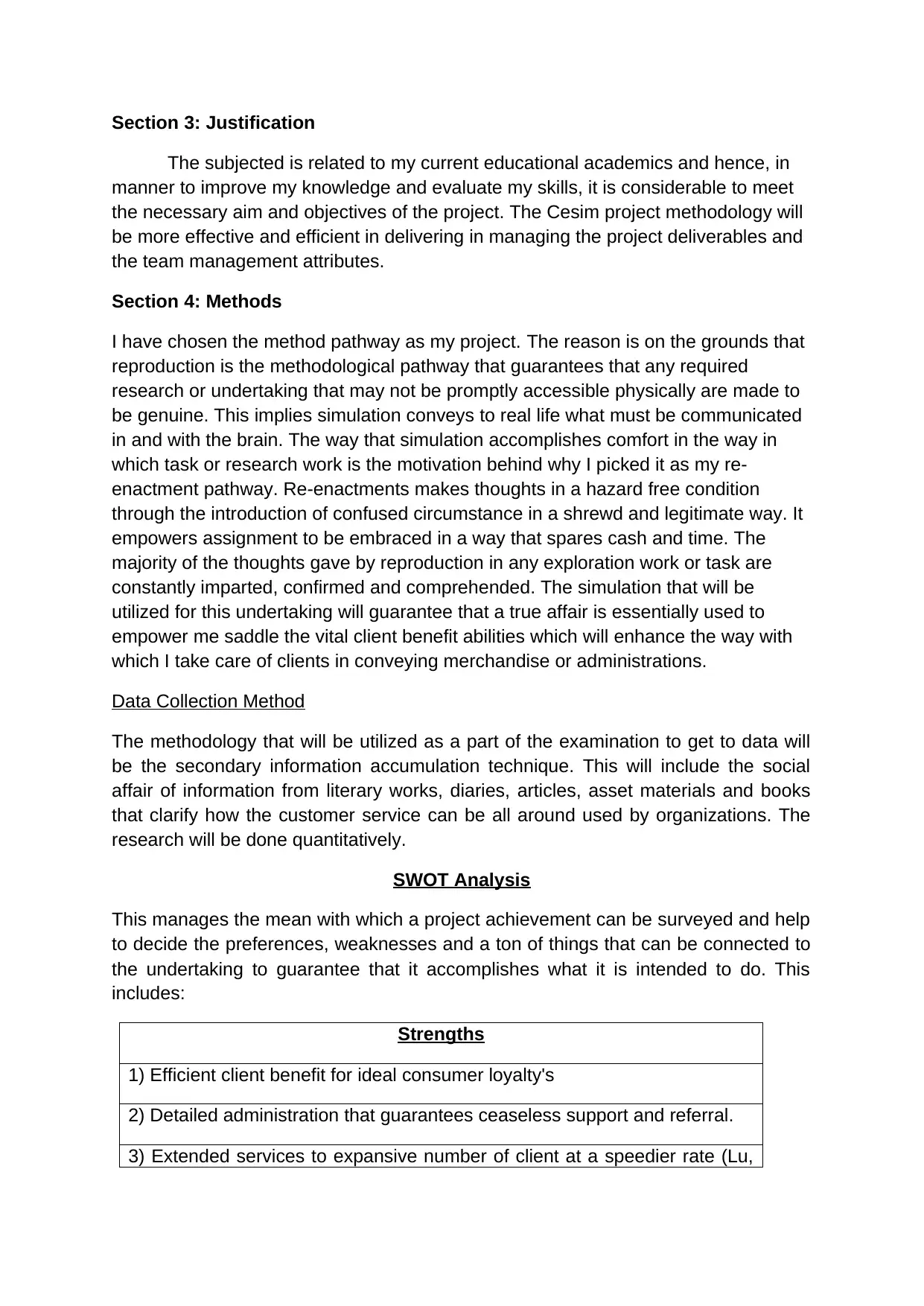
Section 3: Justification
The subjected is related to my current educational academics and hence, in
manner to improve my knowledge and evaluate my skills, it is considerable to meet
the necessary aim and objectives of the project. The Cesim project methodology will
be more effective and efficient in delivering in managing the project deliverables and
the team management attributes.
Section 4: Methods
I have chosen the method pathway as my project. The reason is on the grounds that
reproduction is the methodological pathway that guarantees that any required
research or undertaking that may not be promptly accessible physically are made to
be genuine. This implies simulation conveys to real life what must be communicated
in and with the brain. The way that simulation accomplishes comfort in the way in
which task or research work is the motivation behind why I picked it as my re-
enactment pathway. Re-enactments makes thoughts in a hazard free condition
through the introduction of confused circumstance in a shrewd and legitimate way. It
empowers assignment to be embraced in a way that spares cash and time. The
majority of the thoughts gave by reproduction in any exploration work or task are
constantly imparted, confirmed and comprehended. The simulation that will be
utilized for this undertaking will guarantee that a true affair is essentially used to
empower me saddle the vital client benefit abilities which will enhance the way with
which I take care of clients in conveying merchandise or administrations.
Data Collection Method
The methodology that will be utilized as a part of the examination to get to data will
be the secondary information accumulation technique. This will include the social
affair of information from literary works, diaries, articles, asset materials and books
that clarify how the customer service can be all around used by organizations. The
research will be done quantitatively.
SWOT Analysis
This manages the mean with which a project achievement can be surveyed and help
to decide the preferences, weaknesses and a ton of things that can be connected to
the undertaking to guarantee that it accomplishes what it is intended to do. This
includes:
Strengths
1) Efficient client benefit for ideal consumer loyalty's
2) Detailed administration that guarantees ceaseless support and referral.
3) Extended services to expansive number of client at a speedier rate (Lu,
The subjected is related to my current educational academics and hence, in
manner to improve my knowledge and evaluate my skills, it is considerable to meet
the necessary aim and objectives of the project. The Cesim project methodology will
be more effective and efficient in delivering in managing the project deliverables and
the team management attributes.
Section 4: Methods
I have chosen the method pathway as my project. The reason is on the grounds that
reproduction is the methodological pathway that guarantees that any required
research or undertaking that may not be promptly accessible physically are made to
be genuine. This implies simulation conveys to real life what must be communicated
in and with the brain. The way that simulation accomplishes comfort in the way in
which task or research work is the motivation behind why I picked it as my re-
enactment pathway. Re-enactments makes thoughts in a hazard free condition
through the introduction of confused circumstance in a shrewd and legitimate way. It
empowers assignment to be embraced in a way that spares cash and time. The
majority of the thoughts gave by reproduction in any exploration work or task are
constantly imparted, confirmed and comprehended. The simulation that will be
utilized for this undertaking will guarantee that a true affair is essentially used to
empower me saddle the vital client benefit abilities which will enhance the way with
which I take care of clients in conveying merchandise or administrations.
Data Collection Method
The methodology that will be utilized as a part of the examination to get to data will
be the secondary information accumulation technique. This will include the social
affair of information from literary works, diaries, articles, asset materials and books
that clarify how the customer service can be all around used by organizations. The
research will be done quantitatively.
SWOT Analysis
This manages the mean with which a project achievement can be surveyed and help
to decide the preferences, weaknesses and a ton of things that can be connected to
the undertaking to guarantee that it accomplishes what it is intended to do. This
includes:
Strengths
1) Efficient client benefit for ideal consumer loyalty's
2) Detailed administration that guarantees ceaseless support and referral.
3) Extended services to expansive number of client at a speedier rate (Lu,
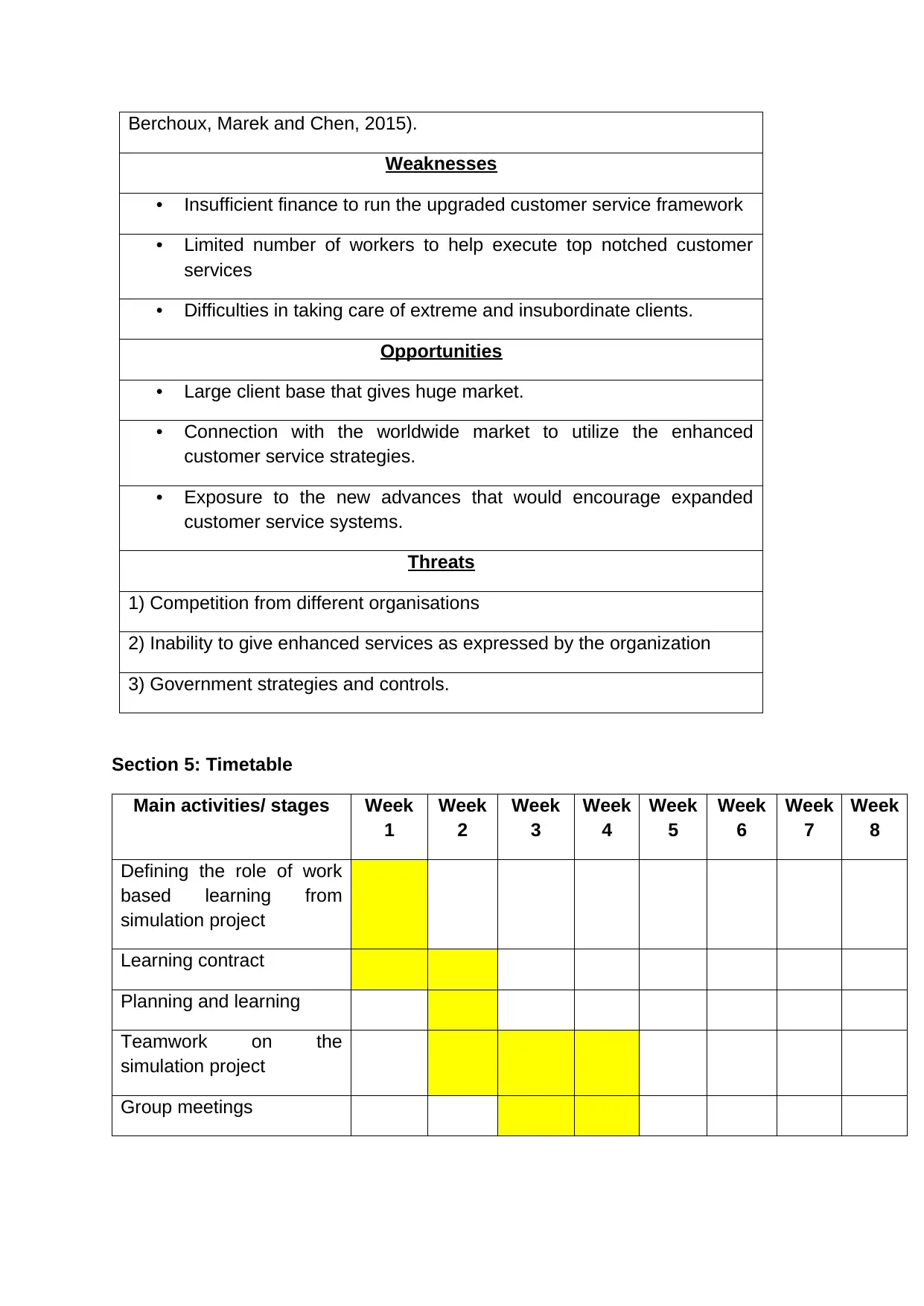
Berchoux, Marek and Chen, 2015).
Weaknesses
• Insufficient finance to run the upgraded customer service framework
• Limited number of workers to help execute top notched customer
services
• Difficulties in taking care of extreme and insubordinate clients.
Opportunities
• Large client base that gives huge market.
• Connection with the worldwide market to utilize the enhanced
customer service strategies.
• Exposure to the new advances that would encourage expanded
customer service systems.
Threats
1) Competition from different organisations
2) Inability to give enhanced services as expressed by the organization
3) Government strategies and controls.
Section 5: Timetable
Main activities/ stages Week
1
Week
2
Week
3
Week
4
Week
5
Week
6
Week
7
Week
8
Defining the role of work
based learning from
simulation project
Learning contract
Planning and learning
Teamwork on the
simulation project
Group meetings
Weaknesses
• Insufficient finance to run the upgraded customer service framework
• Limited number of workers to help execute top notched customer
services
• Difficulties in taking care of extreme and insubordinate clients.
Opportunities
• Large client base that gives huge market.
• Connection with the worldwide market to utilize the enhanced
customer service strategies.
• Exposure to the new advances that would encourage expanded
customer service systems.
Threats
1) Competition from different organisations
2) Inability to give enhanced services as expressed by the organization
3) Government strategies and controls.
Section 5: Timetable
Main activities/ stages Week
1
Week
2
Week
3
Week
4
Week
5
Week
6
Week
7
Week
8
Defining the role of work
based learning from
simulation project
Learning contract
Planning and learning
Teamwork on the
simulation project
Group meetings
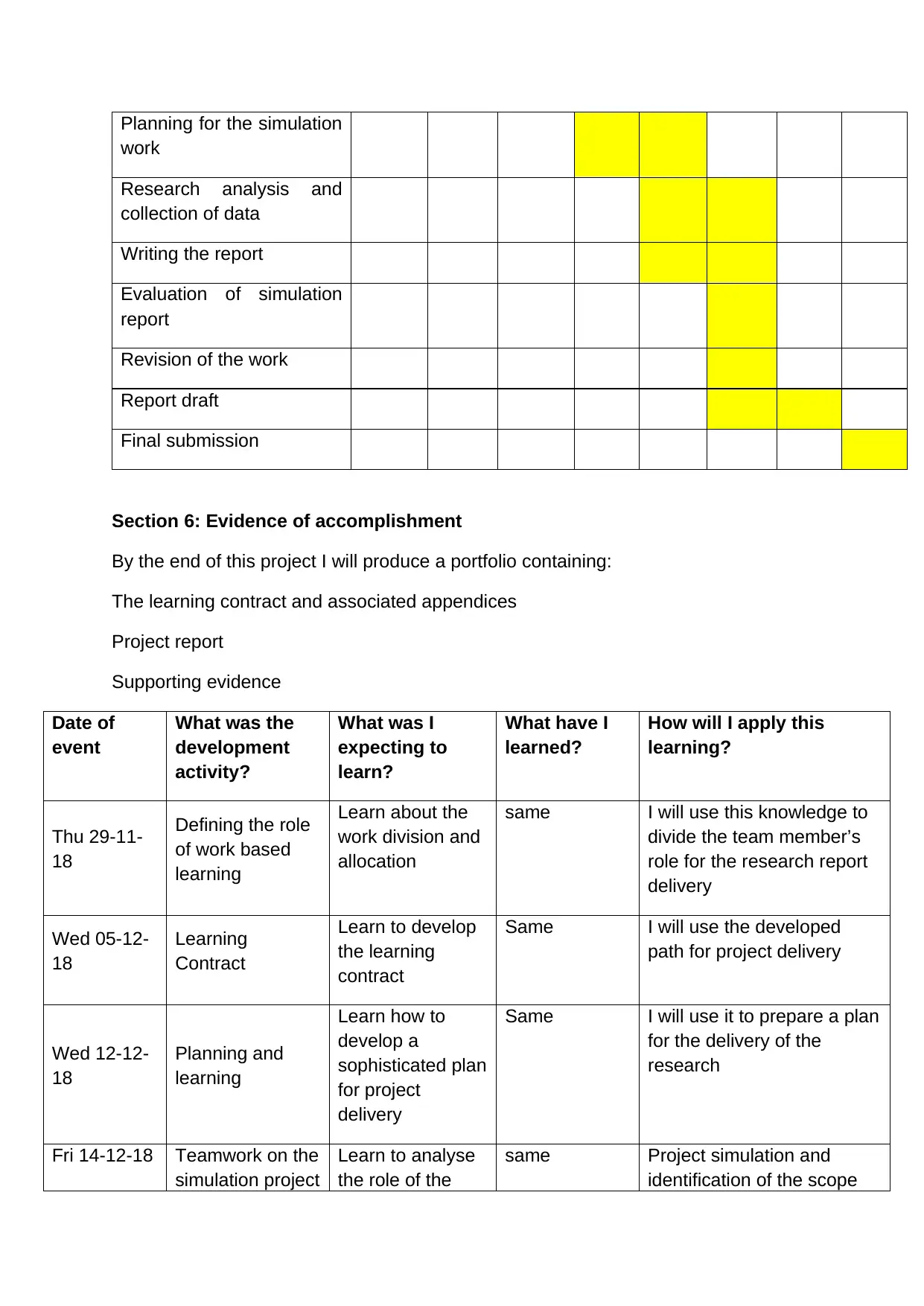
Planning for the simulation
work
Research analysis and
collection of data
Writing the report
Evaluation of simulation
report
Revision of the work
Report draft
Final submission
Section 6: Evidence of accomplishment
By the end of this project I will produce a portfolio containing:
The learning contract and associated appendices
Project report
Supporting evidence
Date of
event
What was the
development
activity?
What was I
expecting to
learn?
What have I
learned?
How will I apply this
learning?
Thu 29-11-
18
Defining the role
of work based
learning
Learn about the
work division and
allocation
same I will use this knowledge to
divide the team member’s
role for the research report
delivery
Wed 05-12-
18
Learning
Contract
Learn to develop
the learning
contract
Same I will use the developed
path for project delivery
Wed 12-12-
18
Planning and
learning
Learn how to
develop a
sophisticated plan
for project
delivery
Same I will use it to prepare a plan
for the delivery of the
research
Fri 14-12-18 Teamwork on the
simulation project
Learn to analyse
the role of the
same Project simulation and
identification of the scope
work
Research analysis and
collection of data
Writing the report
Evaluation of simulation
report
Revision of the work
Report draft
Final submission
Section 6: Evidence of accomplishment
By the end of this project I will produce a portfolio containing:
The learning contract and associated appendices
Project report
Supporting evidence
Date of
event
What was the
development
activity?
What was I
expecting to
learn?
What have I
learned?
How will I apply this
learning?
Thu 29-11-
18
Defining the role
of work based
learning
Learn about the
work division and
allocation
same I will use this knowledge to
divide the team member’s
role for the research report
delivery
Wed 05-12-
18
Learning
Contract
Learn to develop
the learning
contract
Same I will use the developed
path for project delivery
Wed 12-12-
18
Planning and
learning
Learn how to
develop a
sophisticated plan
for project
delivery
Same I will use it to prepare a plan
for the delivery of the
research
Fri 14-12-18 Teamwork on the
simulation project
Learn to analyse
the role of the
same Project simulation and
identification of the scope
Secure Best Marks with AI Grader
Need help grading? Try our AI Grader for instant feedback on your assignments.
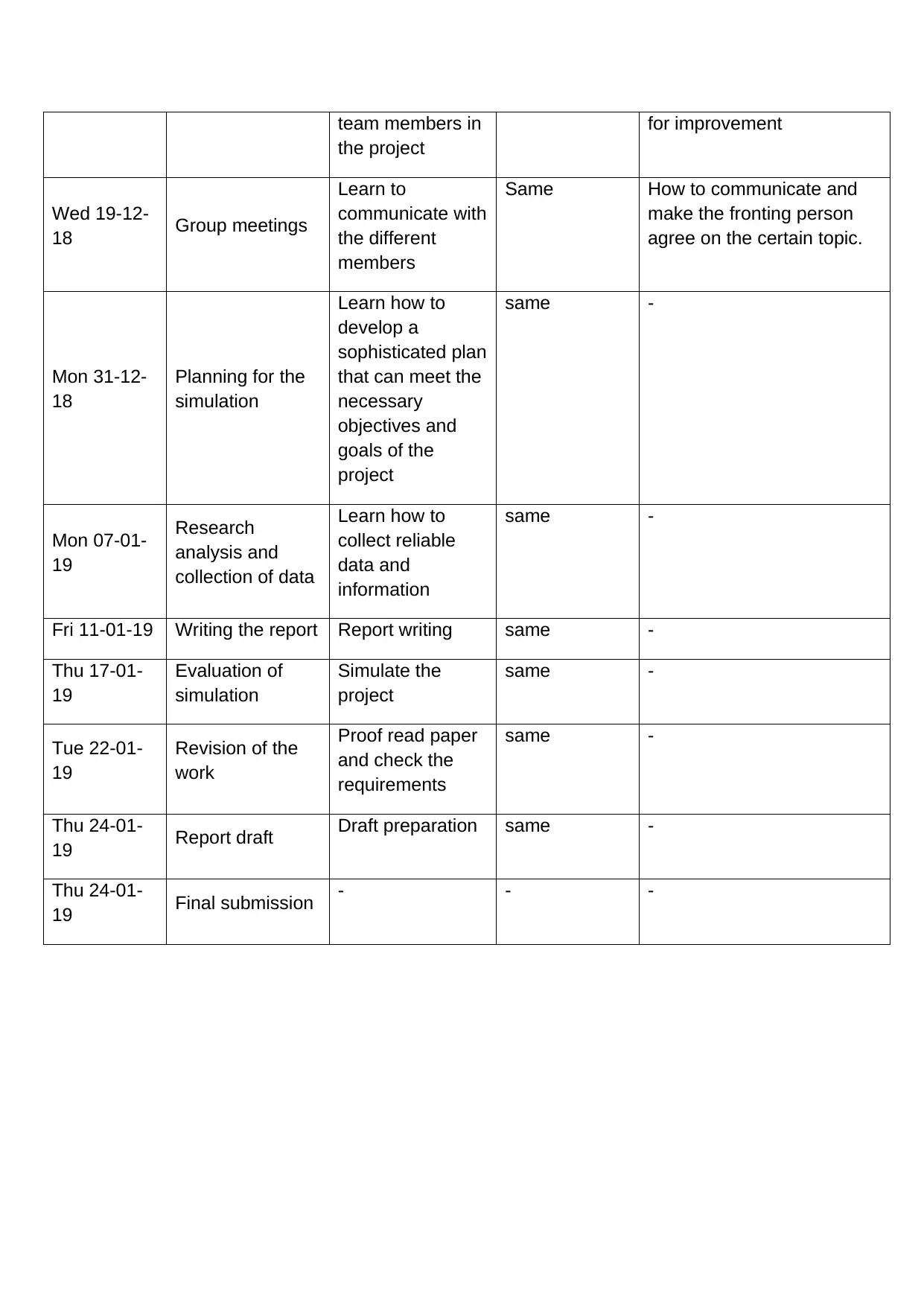
team members in
the project
for improvement
Wed 19-12-
18 Group meetings
Learn to
communicate with
the different
members
Same How to communicate and
make the fronting person
agree on the certain topic.
Mon 31-12-
18
Planning for the
simulation
Learn how to
develop a
sophisticated plan
that can meet the
necessary
objectives and
goals of the
project
same -
Mon 07-01-
19
Research
analysis and
collection of data
Learn how to
collect reliable
data and
information
same -
Fri 11-01-19 Writing the report Report writing same -
Thu 17-01-
19
Evaluation of
simulation
Simulate the
project
same -
Tue 22-01-
19
Revision of the
work
Proof read paper
and check the
requirements
same -
Thu 24-01-
19 Report draft Draft preparation same -
Thu 24-01-
19 Final submission - - -
the project
for improvement
Wed 19-12-
18 Group meetings
Learn to
communicate with
the different
members
Same How to communicate and
make the fronting person
agree on the certain topic.
Mon 31-12-
18
Planning for the
simulation
Learn how to
develop a
sophisticated plan
that can meet the
necessary
objectives and
goals of the
project
same -
Mon 07-01-
19
Research
analysis and
collection of data
Learn how to
collect reliable
data and
information
same -
Fri 11-01-19 Writing the report Report writing same -
Thu 17-01-
19
Evaluation of
simulation
Simulate the
project
same -
Tue 22-01-
19
Revision of the
work
Proof read paper
and check the
requirements
same -
Thu 24-01-
19 Report draft Draft preparation same -
Thu 24-01-
19 Final submission - - -
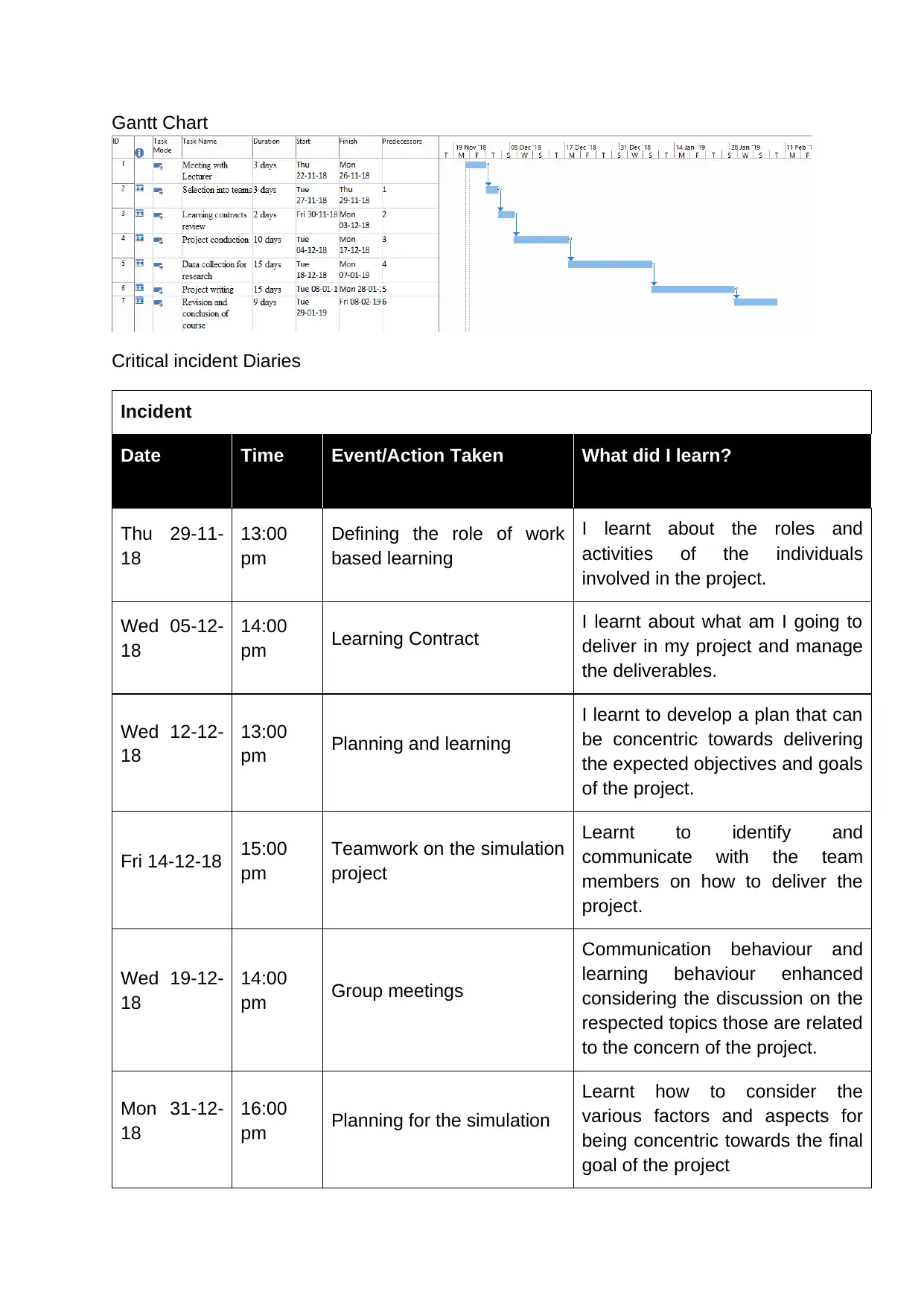
Gantt Chart
Critical incident Diaries
Incident
Date Time Event/Action Taken What did I learn?
Thu 29-11-
18
13:00
pm
Defining the role of work
based learning
I learnt about the roles and
activities of the individuals
involved in the project.
Wed 05-12-
18
14:00
pm Learning Contract I learnt about what am I going to
deliver in my project and manage
the deliverables.
Wed 12-12-
18
13:00
pm Planning and learning
I learnt to develop a plan that can
be concentric towards delivering
the expected objectives and goals
of the project.
Fri 14-12-18 15:00
pm
Teamwork on the simulation
project
Learnt to identify and
communicate with the team
members on how to deliver the
project.
Wed 19-12-
18
14:00
pm Group meetings
Communication behaviour and
learning behaviour enhanced
considering the discussion on the
respected topics those are related
to the concern of the project.
Mon 31-12-
18
16:00
pm Planning for the simulation
Learnt how to consider the
various factors and aspects for
being concentric towards the final
goal of the project
Critical incident Diaries
Incident
Date Time Event/Action Taken What did I learn?
Thu 29-11-
18
13:00
pm
Defining the role of work
based learning
I learnt about the roles and
activities of the individuals
involved in the project.
Wed 05-12-
18
14:00
pm Learning Contract I learnt about what am I going to
deliver in my project and manage
the deliverables.
Wed 12-12-
18
13:00
pm Planning and learning
I learnt to develop a plan that can
be concentric towards delivering
the expected objectives and goals
of the project.
Fri 14-12-18 15:00
pm
Teamwork on the simulation
project
Learnt to identify and
communicate with the team
members on how to deliver the
project.
Wed 19-12-
18
14:00
pm Group meetings
Communication behaviour and
learning behaviour enhanced
considering the discussion on the
respected topics those are related
to the concern of the project.
Mon 31-12-
18
16:00
pm Planning for the simulation
Learnt how to consider the
various factors and aspects for
being concentric towards the final
goal of the project
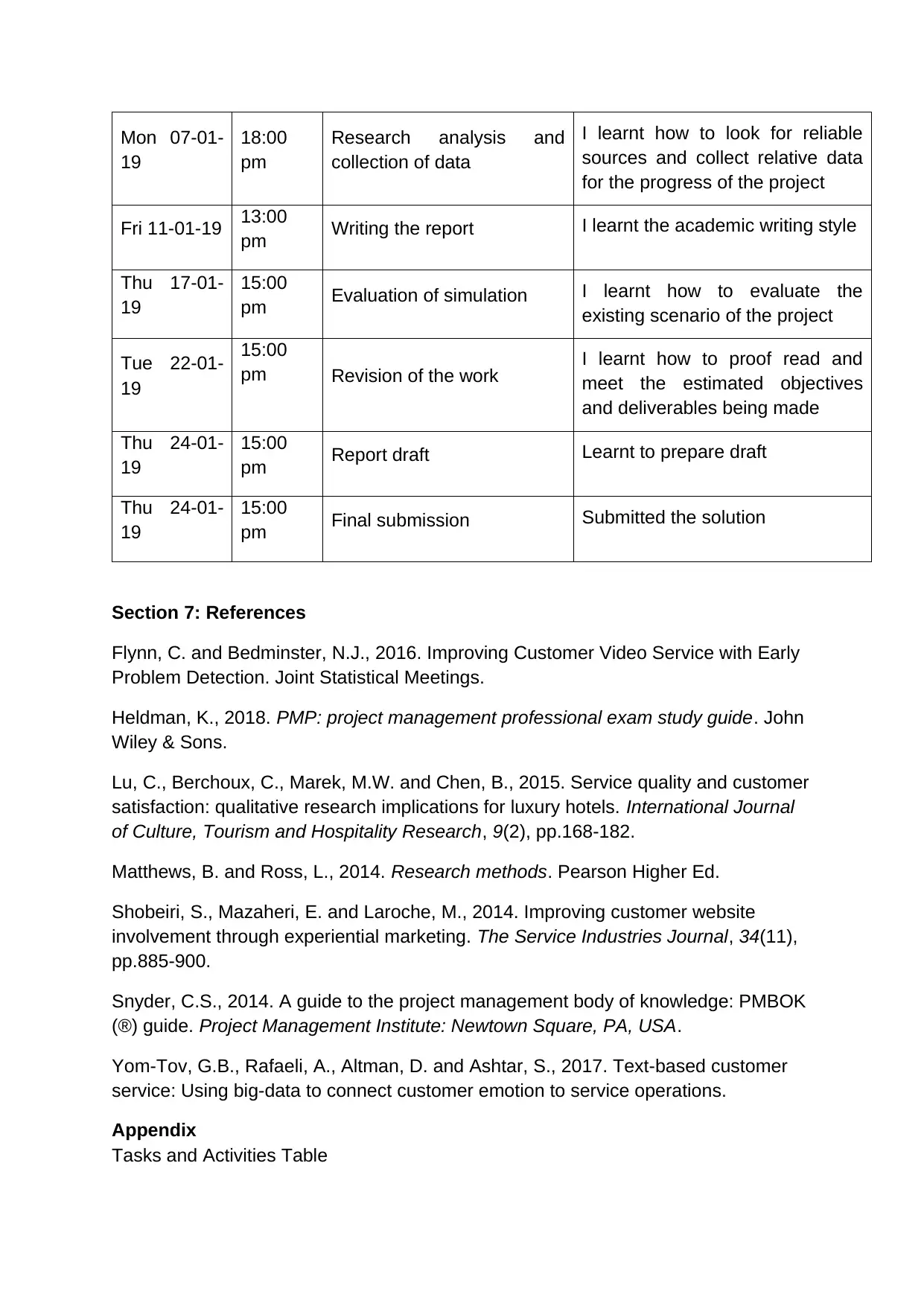
Mon 07-01-
19
18:00
pm
Research analysis and
collection of data
I learnt how to look for reliable
sources and collect relative data
for the progress of the project
Fri 11-01-19 13:00
pm Writing the report I learnt the academic writing style
Thu 17-01-
19
15:00
pm Evaluation of simulation I learnt how to evaluate the
existing scenario of the project
Tue 22-01-
19
15:00
pm Revision of the work I learnt how to proof read and
meet the estimated objectives
and deliverables being made
Thu 24-01-
19
15:00
pm Report draft Learnt to prepare draft
Thu 24-01-
19
15:00
pm Final submission Submitted the solution
Section 7: References
Flynn, C. and Bedminster, N.J., 2016. Improving Customer Video Service with Early
Problem Detection. Joint Statistical Meetings.
Heldman, K., 2018. PMP: project management professional exam study guide. John
Wiley & Sons.
Lu, C., Berchoux, C., Marek, M.W. and Chen, B., 2015. Service quality and customer
satisfaction: qualitative research implications for luxury hotels. International Journal
of Culture, Tourism and Hospitality Research, 9(2), pp.168-182.
Matthews, B. and Ross, L., 2014. Research methods. Pearson Higher Ed.
Shobeiri, S., Mazaheri, E. and Laroche, M., 2014. Improving customer website
involvement through experiential marketing. The Service Industries Journal, 34(11),
pp.885-900.
Snyder, C.S., 2014. A guide to the project management body of knowledge: PMBOK
(®) guide. Project Management Institute: Newtown Square, PA, USA.
Yom-Tov, G.B., Rafaeli, A., Altman, D. and Ashtar, S., 2017. Text-based customer
service: Using big-data to connect customer emotion to service operations.
Appendix
Tasks and Activities Table
19
18:00
pm
Research analysis and
collection of data
I learnt how to look for reliable
sources and collect relative data
for the progress of the project
Fri 11-01-19 13:00
pm Writing the report I learnt the academic writing style
Thu 17-01-
19
15:00
pm Evaluation of simulation I learnt how to evaluate the
existing scenario of the project
Tue 22-01-
19
15:00
pm Revision of the work I learnt how to proof read and
meet the estimated objectives
and deliverables being made
Thu 24-01-
19
15:00
pm Report draft Learnt to prepare draft
Thu 24-01-
19
15:00
pm Final submission Submitted the solution
Section 7: References
Flynn, C. and Bedminster, N.J., 2016. Improving Customer Video Service with Early
Problem Detection. Joint Statistical Meetings.
Heldman, K., 2018. PMP: project management professional exam study guide. John
Wiley & Sons.
Lu, C., Berchoux, C., Marek, M.W. and Chen, B., 2015. Service quality and customer
satisfaction: qualitative research implications for luxury hotels. International Journal
of Culture, Tourism and Hospitality Research, 9(2), pp.168-182.
Matthews, B. and Ross, L., 2014. Research methods. Pearson Higher Ed.
Shobeiri, S., Mazaheri, E. and Laroche, M., 2014. Improving customer website
involvement through experiential marketing. The Service Industries Journal, 34(11),
pp.885-900.
Snyder, C.S., 2014. A guide to the project management body of knowledge: PMBOK
(®) guide. Project Management Institute: Newtown Square, PA, USA.
Yom-Tov, G.B., Rafaeli, A., Altman, D. and Ashtar, S., 2017. Text-based customer
service: Using big-data to connect customer emotion to service operations.
Appendix
Tasks and Activities Table
Paraphrase This Document
Need a fresh take? Get an instant paraphrase of this document with our AI Paraphraser
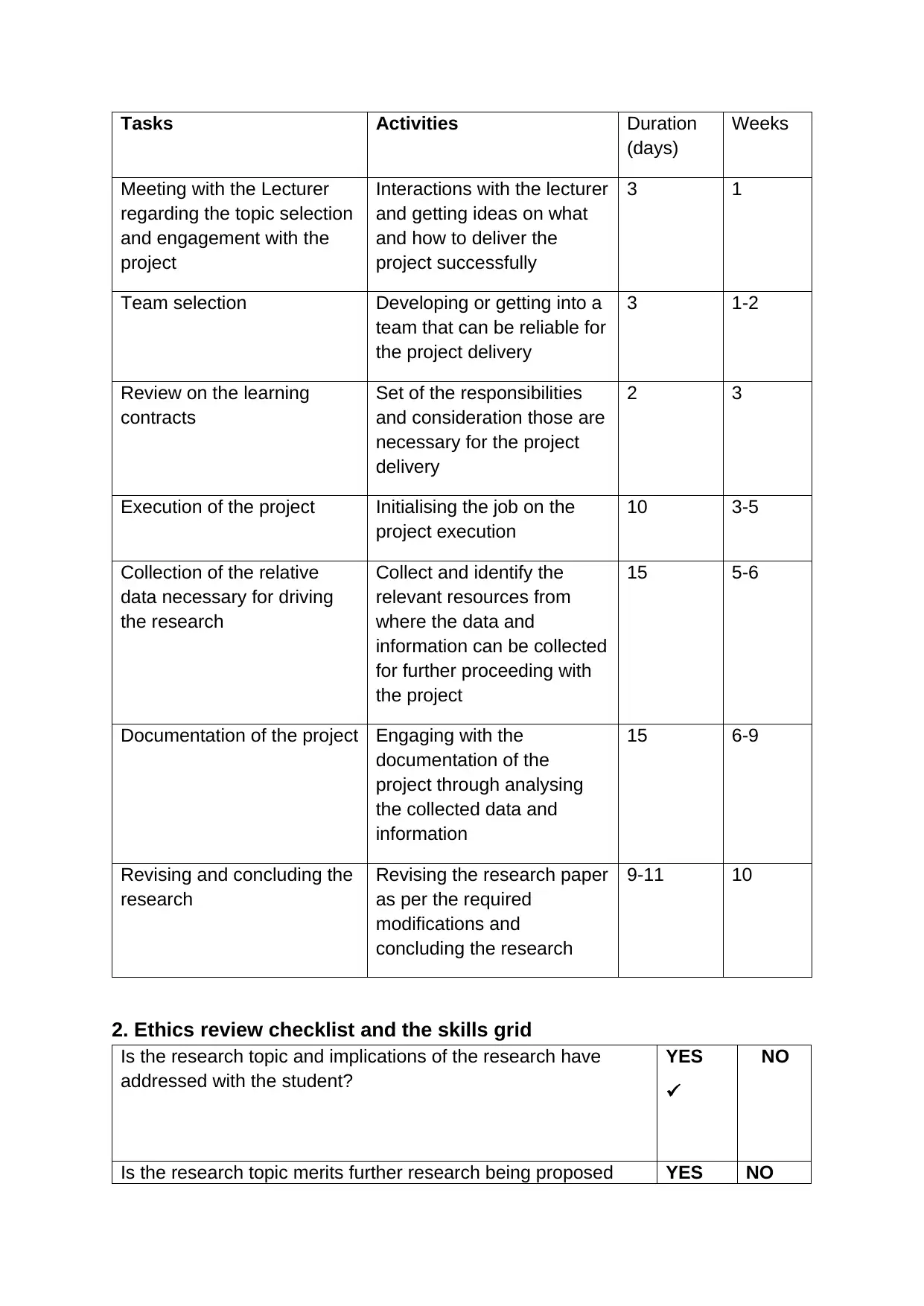
Tasks Activities Duration
(days)
Weeks
Meeting with the Lecturer
regarding the topic selection
and engagement with the
project
Interactions with the lecturer
and getting ideas on what
and how to deliver the
project successfully
3 1
Team selection Developing or getting into a
team that can be reliable for
the project delivery
3 1-2
Review on the learning
contracts
Set of the responsibilities
and consideration those are
necessary for the project
delivery
2 3
Execution of the project Initialising the job on the
project execution
10 3-5
Collection of the relative
data necessary for driving
the research
Collect and identify the
relevant resources from
where the data and
information can be collected
for further proceeding with
the project
15 5-6
Documentation of the project Engaging with the
documentation of the
project through analysing
the collected data and
information
15 6-9
Revising and concluding the
research
Revising the research paper
as per the required
modifications and
concluding the research
9-11 10
2. Ethics review checklist and the skills grid
Is the research topic and implications of the research have
addressed with the student?
YES
NO
Is the research topic merits further research being proposed YES NO
(days)
Weeks
Meeting with the Lecturer
regarding the topic selection
and engagement with the
project
Interactions with the lecturer
and getting ideas on what
and how to deliver the
project successfully
3 1
Team selection Developing or getting into a
team that can be reliable for
the project delivery
3 1-2
Review on the learning
contracts
Set of the responsibilities
and consideration those are
necessary for the project
delivery
2 3
Execution of the project Initialising the job on the
project execution
10 3-5
Collection of the relative
data necessary for driving
the research
Collect and identify the
relevant resources from
where the data and
information can be collected
for further proceeding with
the project
15 5-6
Documentation of the project Engaging with the
documentation of the
project through analysing
the collected data and
information
15 6-9
Revising and concluding the
research
Revising the research paper
as per the required
modifications and
concluding the research
9-11 10
2. Ethics review checklist and the skills grid
Is the research topic and implications of the research have
addressed with the student?
YES
NO
Is the research topic merits further research being proposed YES NO
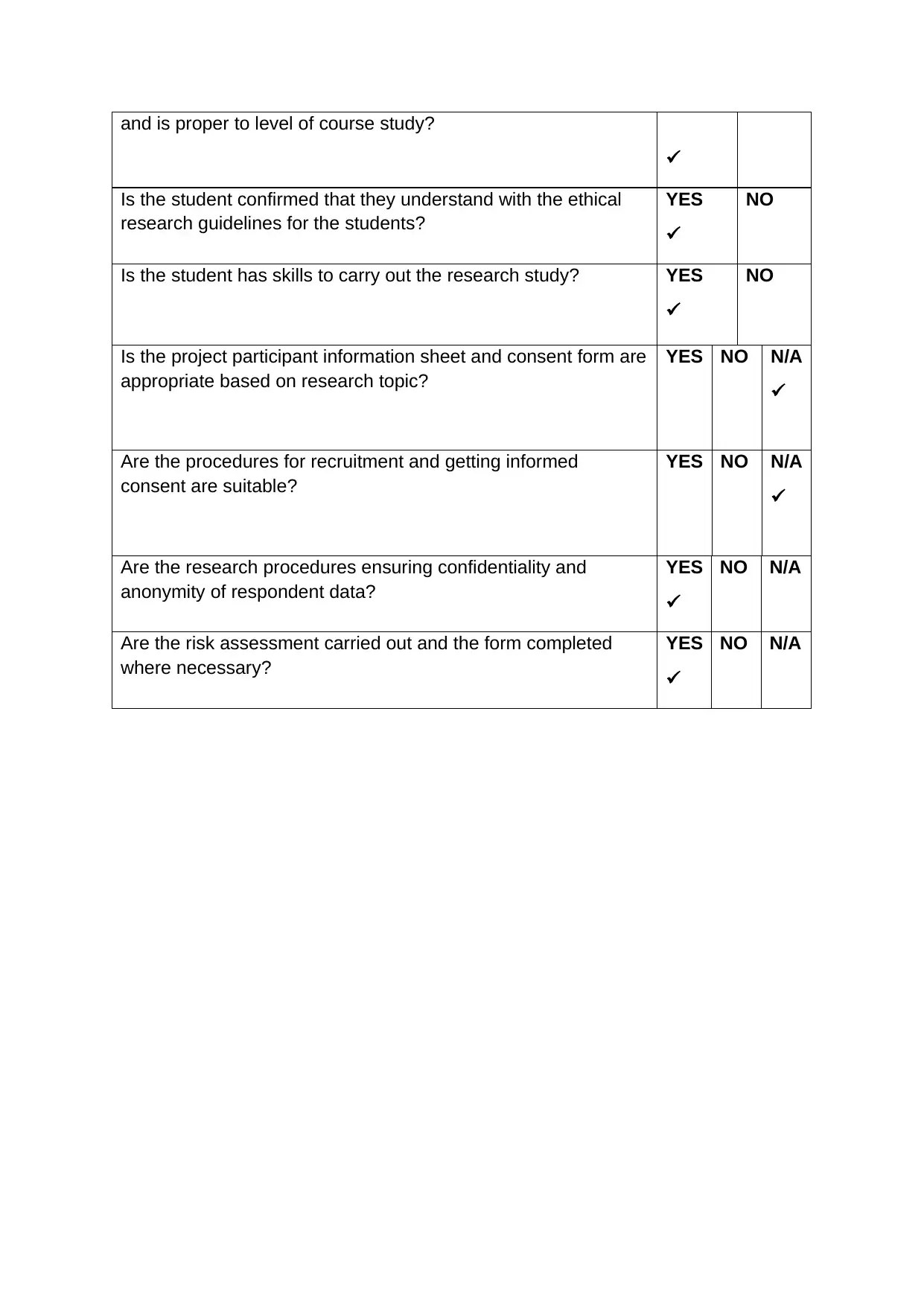
and is proper to level of course study?
Is the student confirmed that they understand with the ethical
research guidelines for the students?
YES
NO
Is the student has skills to carry out the research study? YES
NO
Is the project participant information sheet and consent form are
appropriate based on research topic?
YES NO N/A
Are the procedures for recruitment and getting informed
consent are suitable?
YES NO N/A
Are the research procedures ensuring confidentiality and
anonymity of respondent data?
YES
NO N/A
Are the risk assessment carried out and the form completed
where necessary?
YES
NO N/A
Is the student confirmed that they understand with the ethical
research guidelines for the students?
YES
NO
Is the student has skills to carry out the research study? YES
NO
Is the project participant information sheet and consent form are
appropriate based on research topic?
YES NO N/A
Are the procedures for recruitment and getting informed
consent are suitable?
YES NO N/A
Are the research procedures ensuring confidentiality and
anonymity of respondent data?
YES
NO N/A
Are the risk assessment carried out and the form completed
where necessary?
YES
NO N/A
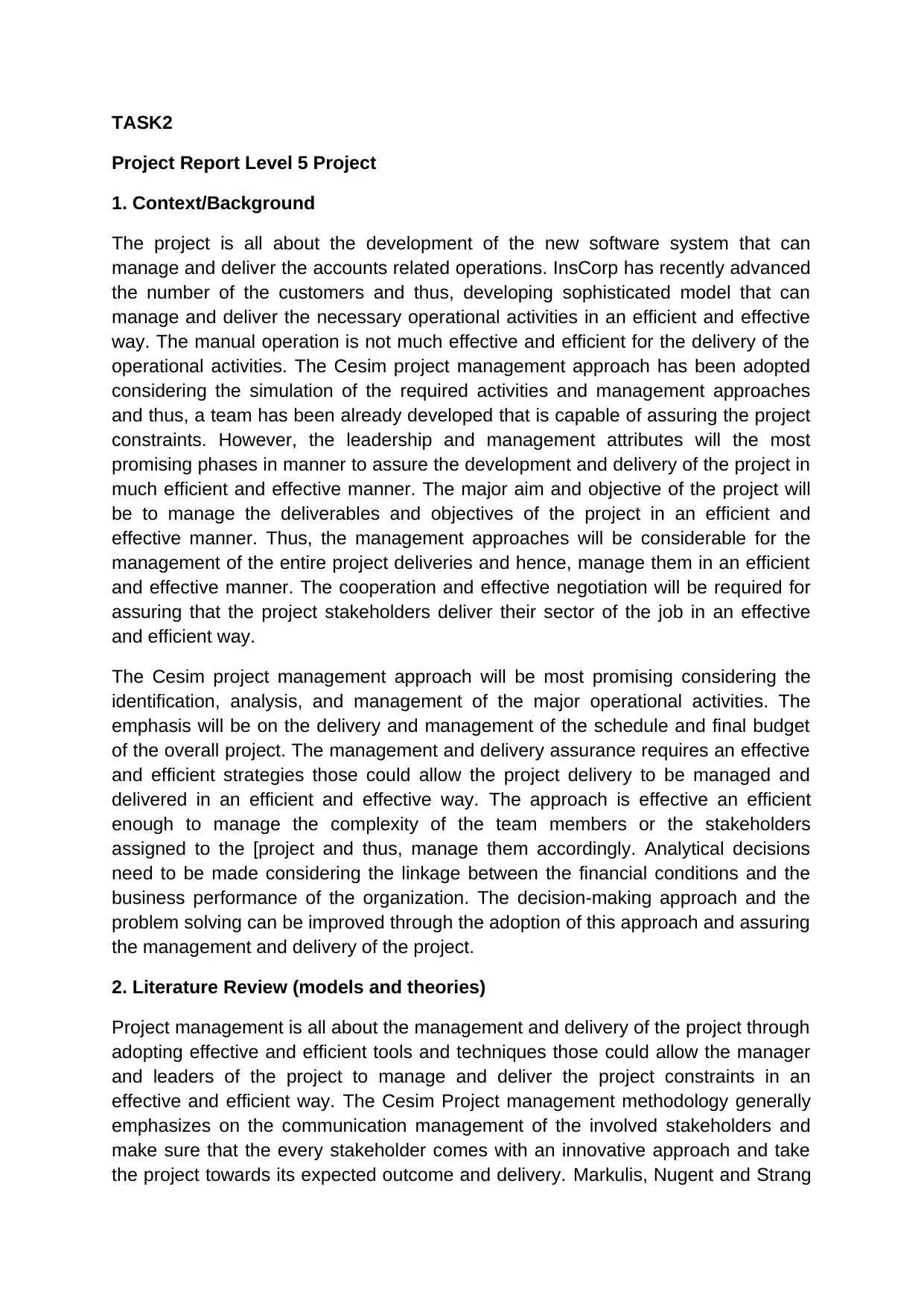
TASK2
Project Report Level 5 Project
1. Context/Background
The project is all about the development of the new software system that can
manage and deliver the accounts related operations. InsCorp has recently advanced
the number of the customers and thus, developing sophisticated model that can
manage and deliver the necessary operational activities in an efficient and effective
way. The manual operation is not much effective and efficient for the delivery of the
operational activities. The Cesim project management approach has been adopted
considering the simulation of the required activities and management approaches
and thus, a team has been already developed that is capable of assuring the project
constraints. However, the leadership and management attributes will the most
promising phases in manner to assure the development and delivery of the project in
much efficient and effective manner. The major aim and objective of the project will
be to manage the deliverables and objectives of the project in an efficient and
effective manner. Thus, the management approaches will be considerable for the
management of the entire project deliveries and hence, manage them in an efficient
and effective manner. The cooperation and effective negotiation will be required for
assuring that the project stakeholders deliver their sector of the job in an effective
and efficient way.
The Cesim project management approach will be most promising considering the
identification, analysis, and management of the major operational activities. The
emphasis will be on the delivery and management of the schedule and final budget
of the overall project. The management and delivery assurance requires an effective
and efficient strategies those could allow the project delivery to be managed and
delivered in an efficient and effective way. The approach is effective an efficient
enough to manage the complexity of the team members or the stakeholders
assigned to the [project and thus, manage them accordingly. Analytical decisions
need to be made considering the linkage between the financial conditions and the
business performance of the organization. The decision-making approach and the
problem solving can be improved through the adoption of this approach and assuring
the management and delivery of the project.
2. Literature Review (models and theories)
Project management is all about the management and delivery of the project through
adopting effective and efficient tools and techniques those could allow the manager
and leaders of the project to manage and deliver the project constraints in an
effective and efficient way. The Cesim Project management methodology generally
emphasizes on the communication management of the involved stakeholders and
make sure that the every stakeholder comes with an innovative approach and take
the project towards its expected outcome and delivery. Markulis, Nugent and Strang
Project Report Level 5 Project
1. Context/Background
The project is all about the development of the new software system that can
manage and deliver the accounts related operations. InsCorp has recently advanced
the number of the customers and thus, developing sophisticated model that can
manage and deliver the necessary operational activities in an efficient and effective
way. The manual operation is not much effective and efficient for the delivery of the
operational activities. The Cesim project management approach has been adopted
considering the simulation of the required activities and management approaches
and thus, a team has been already developed that is capable of assuring the project
constraints. However, the leadership and management attributes will the most
promising phases in manner to assure the development and delivery of the project in
much efficient and effective manner. The major aim and objective of the project will
be to manage the deliverables and objectives of the project in an efficient and
effective manner. Thus, the management approaches will be considerable for the
management of the entire project deliveries and hence, manage them in an efficient
and effective manner. The cooperation and effective negotiation will be required for
assuring that the project stakeholders deliver their sector of the job in an effective
and efficient way.
The Cesim project management approach will be most promising considering the
identification, analysis, and management of the major operational activities. The
emphasis will be on the delivery and management of the schedule and final budget
of the overall project. The management and delivery assurance requires an effective
and efficient strategies those could allow the project delivery to be managed and
delivered in an efficient and effective way. The approach is effective an efficient
enough to manage the complexity of the team members or the stakeholders
assigned to the [project and thus, manage them accordingly. Analytical decisions
need to be made considering the linkage between the financial conditions and the
business performance of the organization. The decision-making approach and the
problem solving can be improved through the adoption of this approach and assuring
the management and delivery of the project.
2. Literature Review (models and theories)
Project management is all about the management and delivery of the project through
adopting effective and efficient tools and techniques those could allow the manager
and leaders of the project to manage and deliver the project constraints in an
effective and efficient way. The Cesim Project management methodology generally
emphasizes on the communication management of the involved stakeholders and
make sure that the every stakeholder comes with an innovative approach and take
the project towards its expected outcome and delivery. Markulis, Nugent and Strang
Secure Best Marks with AI Grader
Need help grading? Try our AI Grader for instant feedback on your assignments.
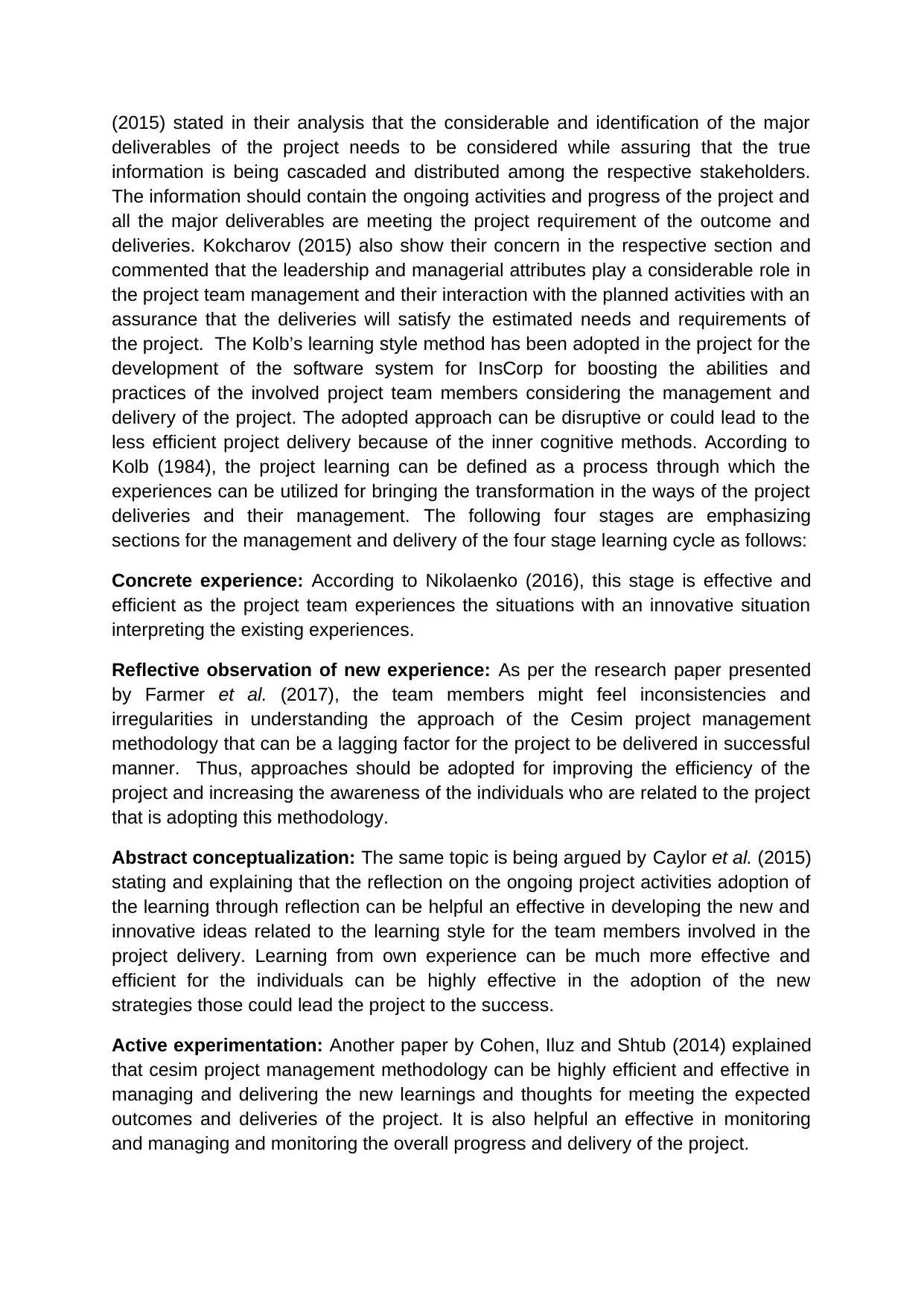
(2015) stated in their analysis that the considerable and identification of the major
deliverables of the project needs to be considered while assuring that the true
information is being cascaded and distributed among the respective stakeholders.
The information should contain the ongoing activities and progress of the project and
all the major deliverables are meeting the project requirement of the outcome and
deliveries. Kokcharov (2015) also show their concern in the respective section and
commented that the leadership and managerial attributes play a considerable role in
the project team management and their interaction with the planned activities with an
assurance that the deliveries will satisfy the estimated needs and requirements of
the project. The Kolb’s learning style method has been adopted in the project for the
development of the software system for InsCorp for boosting the abilities and
practices of the involved project team members considering the management and
delivery of the project. The adopted approach can be disruptive or could lead to the
less efficient project delivery because of the inner cognitive methods. According to
Kolb (1984), the project learning can be defined as a process through which the
experiences can be utilized for bringing the transformation in the ways of the project
deliveries and their management. The following four stages are emphasizing
sections for the management and delivery of the four stage learning cycle as follows:
Concrete experience: According to Nikolaenko (2016), this stage is effective and
efficient as the project team experiences the situations with an innovative situation
interpreting the existing experiences.
Reflective observation of new experience: As per the research paper presented
by Farmer et al. (2017), the team members might feel inconsistencies and
irregularities in understanding the approach of the Cesim project management
methodology that can be a lagging factor for the project to be delivered in successful
manner. Thus, approaches should be adopted for improving the efficiency of the
project and increasing the awareness of the individuals who are related to the project
that is adopting this methodology.
Abstract conceptualization: The same topic is being argued by Caylor et al. (2015)
stating and explaining that the reflection on the ongoing project activities adoption of
the learning through reflection can be helpful an effective in developing the new and
innovative ideas related to the learning style for the team members involved in the
project delivery. Learning from own experience can be much more effective and
efficient for the individuals can be highly effective in the adoption of the new
strategies those could lead the project to the success.
Active experimentation: Another paper by Cohen, Iluz and Shtub (2014) explained
that cesim project management methodology can be highly efficient and effective in
managing and delivering the new learnings and thoughts for meeting the expected
outcomes and deliveries of the project. It is also helpful an effective in monitoring
and managing and monitoring the overall progress and delivery of the project.
deliverables of the project needs to be considered while assuring that the true
information is being cascaded and distributed among the respective stakeholders.
The information should contain the ongoing activities and progress of the project and
all the major deliverables are meeting the project requirement of the outcome and
deliveries. Kokcharov (2015) also show their concern in the respective section and
commented that the leadership and managerial attributes play a considerable role in
the project team management and their interaction with the planned activities with an
assurance that the deliveries will satisfy the estimated needs and requirements of
the project. The Kolb’s learning style method has been adopted in the project for the
development of the software system for InsCorp for boosting the abilities and
practices of the involved project team members considering the management and
delivery of the project. The adopted approach can be disruptive or could lead to the
less efficient project delivery because of the inner cognitive methods. According to
Kolb (1984), the project learning can be defined as a process through which the
experiences can be utilized for bringing the transformation in the ways of the project
deliveries and their management. The following four stages are emphasizing
sections for the management and delivery of the four stage learning cycle as follows:
Concrete experience: According to Nikolaenko (2016), this stage is effective and
efficient as the project team experiences the situations with an innovative situation
interpreting the existing experiences.
Reflective observation of new experience: As per the research paper presented
by Farmer et al. (2017), the team members might feel inconsistencies and
irregularities in understanding the approach of the Cesim project management
methodology that can be a lagging factor for the project to be delivered in successful
manner. Thus, approaches should be adopted for improving the efficiency of the
project and increasing the awareness of the individuals who are related to the project
that is adopting this methodology.
Abstract conceptualization: The same topic is being argued by Caylor et al. (2015)
stating and explaining that the reflection on the ongoing project activities adoption of
the learning through reflection can be helpful an effective in developing the new and
innovative ideas related to the learning style for the team members involved in the
project delivery. Learning from own experience can be much more effective and
efficient for the individuals can be highly effective in the adoption of the new
strategies those could lead the project to the success.
Active experimentation: Another paper by Cohen, Iluz and Shtub (2014) explained
that cesim project management methodology can be highly efficient and effective in
managing and delivering the new learnings and thoughts for meeting the expected
outcomes and deliveries of the project. It is also helpful an effective in monitoring
and managing and monitoring the overall progress and delivery of the project.
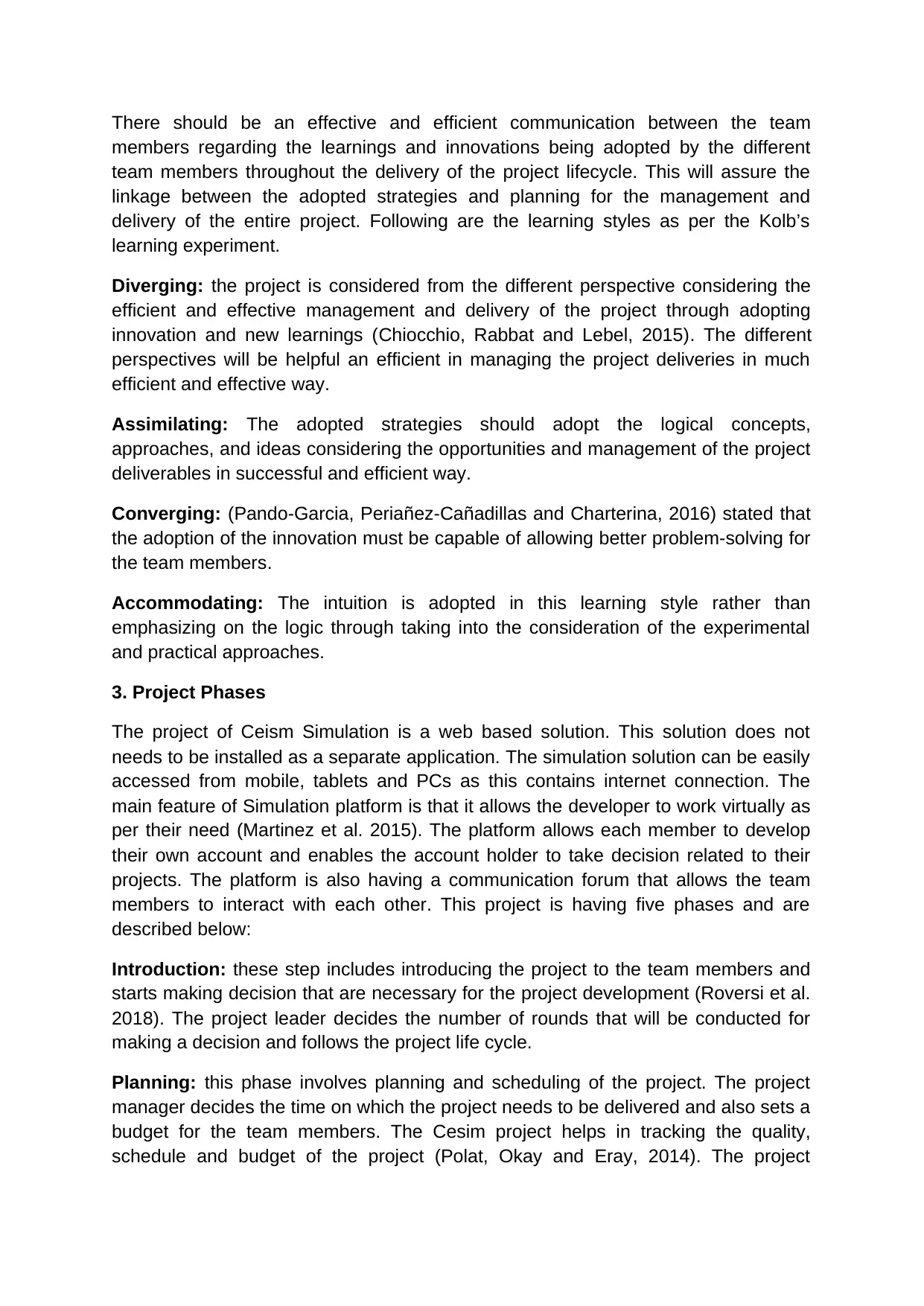
There should be an effective and efficient communication between the team
members regarding the learnings and innovations being adopted by the different
team members throughout the delivery of the project lifecycle. This will assure the
linkage between the adopted strategies and planning for the management and
delivery of the entire project. Following are the learning styles as per the Kolb’s
learning experiment.
Diverging: the project is considered from the different perspective considering the
efficient and effective management and delivery of the project through adopting
innovation and new learnings (Chiocchio, Rabbat and Lebel, 2015). The different
perspectives will be helpful an efficient in managing the project deliveries in much
efficient and effective way.
Assimilating: The adopted strategies should adopt the logical concepts,
approaches, and ideas considering the opportunities and management of the project
deliverables in successful and efficient way.
Converging: (Pando-Garcia, Periañez-Cañadillas and Charterina, 2016) stated that
the adoption of the innovation must be capable of allowing better problem-solving for
the team members.
Accommodating: The intuition is adopted in this learning style rather than
emphasizing on the logic through taking into the consideration of the experimental
and practical approaches.
3. Project Phases
The project of Ceism Simulation is a web based solution. This solution does not
needs to be installed as a separate application. The simulation solution can be easily
accessed from mobile, tablets and PCs as this contains internet connection. The
main feature of Simulation platform is that it allows the developer to work virtually as
per their need (Martinez et al. 2015). The platform allows each member to develop
their own account and enables the account holder to take decision related to their
projects. The platform is also having a communication forum that allows the team
members to interact with each other. This project is having five phases and are
described below:
Introduction: these step includes introducing the project to the team members and
starts making decision that are necessary for the project development (Roversi et al.
2018). The project leader decides the number of rounds that will be conducted for
making a decision and follows the project life cycle.
Planning: this phase involves planning and scheduling of the project. The project
manager decides the time on which the project needs to be delivered and also sets a
budget for the team members. The Cesim project helps in tracking the quality,
schedule and budget of the project (Polat, Okay and Eray, 2014). The project
members regarding the learnings and innovations being adopted by the different
team members throughout the delivery of the project lifecycle. This will assure the
linkage between the adopted strategies and planning for the management and
delivery of the entire project. Following are the learning styles as per the Kolb’s
learning experiment.
Diverging: the project is considered from the different perspective considering the
efficient and effective management and delivery of the project through adopting
innovation and new learnings (Chiocchio, Rabbat and Lebel, 2015). The different
perspectives will be helpful an efficient in managing the project deliveries in much
efficient and effective way.
Assimilating: The adopted strategies should adopt the logical concepts,
approaches, and ideas considering the opportunities and management of the project
deliverables in successful and efficient way.
Converging: (Pando-Garcia, Periañez-Cañadillas and Charterina, 2016) stated that
the adoption of the innovation must be capable of allowing better problem-solving for
the team members.
Accommodating: The intuition is adopted in this learning style rather than
emphasizing on the logic through taking into the consideration of the experimental
and practical approaches.
3. Project Phases
The project of Ceism Simulation is a web based solution. This solution does not
needs to be installed as a separate application. The simulation solution can be easily
accessed from mobile, tablets and PCs as this contains internet connection. The
main feature of Simulation platform is that it allows the developer to work virtually as
per their need (Martinez et al. 2015). The platform allows each member to develop
their own account and enables the account holder to take decision related to their
projects. The platform is also having a communication forum that allows the team
members to interact with each other. This project is having five phases and are
described below:
Introduction: these step includes introducing the project to the team members and
starts making decision that are necessary for the project development (Roversi et al.
2018). The project leader decides the number of rounds that will be conducted for
making a decision and follows the project life cycle.
Planning: this phase involves planning and scheduling of the project. The project
manager decides the time on which the project needs to be delivered and also sets a
budget for the team members. The Cesim project helps in tracking the quality,
schedule and budget of the project (Polat, Okay and Eray, 2014). The project
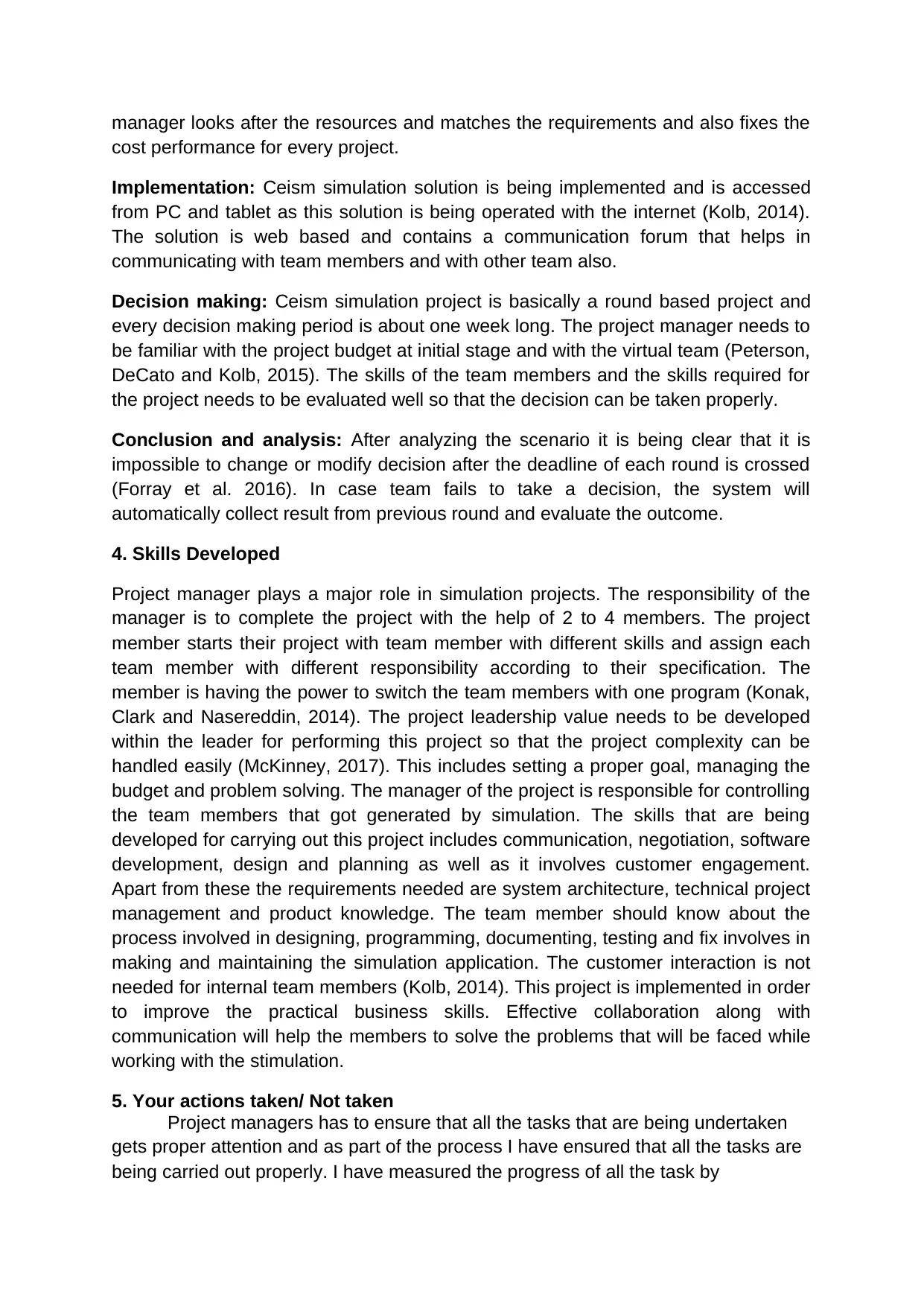
manager looks after the resources and matches the requirements and also fixes the
cost performance for every project.
Implementation: Ceism simulation solution is being implemented and is accessed
from PC and tablet as this solution is being operated with the internet (Kolb, 2014).
The solution is web based and contains a communication forum that helps in
communicating with team members and with other team also.
Decision making: Ceism simulation project is basically a round based project and
every decision making period is about one week long. The project manager needs to
be familiar with the project budget at initial stage and with the virtual team (Peterson,
DeCato and Kolb, 2015). The skills of the team members and the skills required for
the project needs to be evaluated well so that the decision can be taken properly.
Conclusion and analysis: After analyzing the scenario it is being clear that it is
impossible to change or modify decision after the deadline of each round is crossed
(Forray et al. 2016). In case team fails to take a decision, the system will
automatically collect result from previous round and evaluate the outcome.
4. Skills Developed
Project manager plays a major role in simulation projects. The responsibility of the
manager is to complete the project with the help of 2 to 4 members. The project
member starts their project with team member with different skills and assign each
team member with different responsibility according to their specification. The
member is having the power to switch the team members with one program (Konak,
Clark and Nasereddin, 2014). The project leadership value needs to be developed
within the leader for performing this project so that the project complexity can be
handled easily (McKinney, 2017). This includes setting a proper goal, managing the
budget and problem solving. The manager of the project is responsible for controlling
the team members that got generated by simulation. The skills that are being
developed for carrying out this project includes communication, negotiation, software
development, design and planning as well as it involves customer engagement.
Apart from these the requirements needed are system architecture, technical project
management and product knowledge. The team member should know about the
process involved in designing, programming, documenting, testing and fix involves in
making and maintaining the simulation application. The customer interaction is not
needed for internal team members (Kolb, 2014). This project is implemented in order
to improve the practical business skills. Effective collaboration along with
communication will help the members to solve the problems that will be faced while
working with the stimulation.
5. Your actions taken/ Not taken
Project managers has to ensure that all the tasks that are being undertaken
gets proper attention and as part of the process I have ensured that all the tasks are
being carried out properly. I have measured the progress of all the task by
cost performance for every project.
Implementation: Ceism simulation solution is being implemented and is accessed
from PC and tablet as this solution is being operated with the internet (Kolb, 2014).
The solution is web based and contains a communication forum that helps in
communicating with team members and with other team also.
Decision making: Ceism simulation project is basically a round based project and
every decision making period is about one week long. The project manager needs to
be familiar with the project budget at initial stage and with the virtual team (Peterson,
DeCato and Kolb, 2015). The skills of the team members and the skills required for
the project needs to be evaluated well so that the decision can be taken properly.
Conclusion and analysis: After analyzing the scenario it is being clear that it is
impossible to change or modify decision after the deadline of each round is crossed
(Forray et al. 2016). In case team fails to take a decision, the system will
automatically collect result from previous round and evaluate the outcome.
4. Skills Developed
Project manager plays a major role in simulation projects. The responsibility of the
manager is to complete the project with the help of 2 to 4 members. The project
member starts their project with team member with different skills and assign each
team member with different responsibility according to their specification. The
member is having the power to switch the team members with one program (Konak,
Clark and Nasereddin, 2014). The project leadership value needs to be developed
within the leader for performing this project so that the project complexity can be
handled easily (McKinney, 2017). This includes setting a proper goal, managing the
budget and problem solving. The manager of the project is responsible for controlling
the team members that got generated by simulation. The skills that are being
developed for carrying out this project includes communication, negotiation, software
development, design and planning as well as it involves customer engagement.
Apart from these the requirements needed are system architecture, technical project
management and product knowledge. The team member should know about the
process involved in designing, programming, documenting, testing and fix involves in
making and maintaining the simulation application. The customer interaction is not
needed for internal team members (Kolb, 2014). This project is implemented in order
to improve the practical business skills. Effective collaboration along with
communication will help the members to solve the problems that will be faced while
working with the stimulation.
5. Your actions taken/ Not taken
Project managers has to ensure that all the tasks that are being undertaken
gets proper attention and as part of the process I have ensured that all the tasks are
being carried out properly. I have measured the progress of all the task by
Paraphrase This Document
Need a fresh take? Get an instant paraphrase of this document with our AI Paraphraser
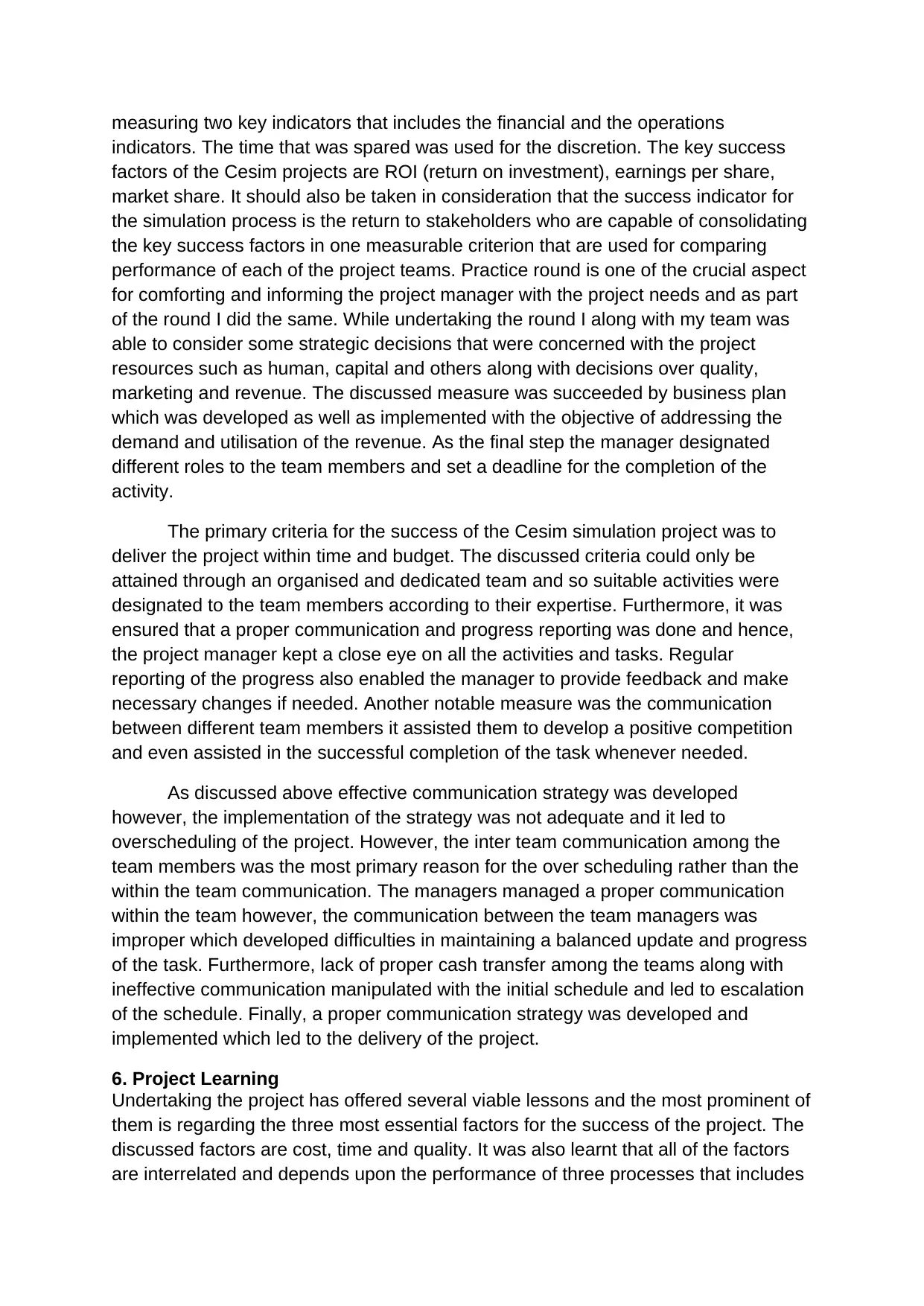
measuring two key indicators that includes the financial and the operations
indicators. The time that was spared was used for the discretion. The key success
factors of the Cesim projects are ROI (return on investment), earnings per share,
market share. It should also be taken in consideration that the success indicator for
the simulation process is the return to stakeholders who are capable of consolidating
the key success factors in one measurable criterion that are used for comparing
performance of each of the project teams. Practice round is one of the crucial aspect
for comforting and informing the project manager with the project needs and as part
of the round I did the same. While undertaking the round I along with my team was
able to consider some strategic decisions that were concerned with the project
resources such as human, capital and others along with decisions over quality,
marketing and revenue. The discussed measure was succeeded by business plan
which was developed as well as implemented with the objective of addressing the
demand and utilisation of the revenue. As the final step the manager designated
different roles to the team members and set a deadline for the completion of the
activity.
The primary criteria for the success of the Cesim simulation project was to
deliver the project within time and budget. The discussed criteria could only be
attained through an organised and dedicated team and so suitable activities were
designated to the team members according to their expertise. Furthermore, it was
ensured that a proper communication and progress reporting was done and hence,
the project manager kept a close eye on all the activities and tasks. Regular
reporting of the progress also enabled the manager to provide feedback and make
necessary changes if needed. Another notable measure was the communication
between different team members it assisted them to develop a positive competition
and even assisted in the successful completion of the task whenever needed.
As discussed above effective communication strategy was developed
however, the implementation of the strategy was not adequate and it led to
overscheduling of the project. However, the inter team communication among the
team members was the most primary reason for the over scheduling rather than the
within the team communication. The managers managed a proper communication
within the team however, the communication between the team managers was
improper which developed difficulties in maintaining a balanced update and progress
of the task. Furthermore, lack of proper cash transfer among the teams along with
ineffective communication manipulated with the initial schedule and led to escalation
of the schedule. Finally, a proper communication strategy was developed and
implemented which led to the delivery of the project.
6. Project Learning
Undertaking the project has offered several viable lessons and the most prominent of
them is regarding the three most essential factors for the success of the project. The
discussed factors are cost, time and quality. It was also learnt that all of the factors
are interrelated and depends upon the performance of three processes that includes
indicators. The time that was spared was used for the discretion. The key success
factors of the Cesim projects are ROI (return on investment), earnings per share,
market share. It should also be taken in consideration that the success indicator for
the simulation process is the return to stakeholders who are capable of consolidating
the key success factors in one measurable criterion that are used for comparing
performance of each of the project teams. Practice round is one of the crucial aspect
for comforting and informing the project manager with the project needs and as part
of the round I did the same. While undertaking the round I along with my team was
able to consider some strategic decisions that were concerned with the project
resources such as human, capital and others along with decisions over quality,
marketing and revenue. The discussed measure was succeeded by business plan
which was developed as well as implemented with the objective of addressing the
demand and utilisation of the revenue. As the final step the manager designated
different roles to the team members and set a deadline for the completion of the
activity.
The primary criteria for the success of the Cesim simulation project was to
deliver the project within time and budget. The discussed criteria could only be
attained through an organised and dedicated team and so suitable activities were
designated to the team members according to their expertise. Furthermore, it was
ensured that a proper communication and progress reporting was done and hence,
the project manager kept a close eye on all the activities and tasks. Regular
reporting of the progress also enabled the manager to provide feedback and make
necessary changes if needed. Another notable measure was the communication
between different team members it assisted them to develop a positive competition
and even assisted in the successful completion of the task whenever needed.
As discussed above effective communication strategy was developed
however, the implementation of the strategy was not adequate and it led to
overscheduling of the project. However, the inter team communication among the
team members was the most primary reason for the over scheduling rather than the
within the team communication. The managers managed a proper communication
within the team however, the communication between the team managers was
improper which developed difficulties in maintaining a balanced update and progress
of the task. Furthermore, lack of proper cash transfer among the teams along with
ineffective communication manipulated with the initial schedule and led to escalation
of the schedule. Finally, a proper communication strategy was developed and
implemented which led to the delivery of the project.
6. Project Learning
Undertaking the project has offered several viable lessons and the most prominent of
them is regarding the three most essential factors for the success of the project. The
discussed factors are cost, time and quality. It was also learnt that all of the factors
are interrelated and depends upon the performance of three processes that includes
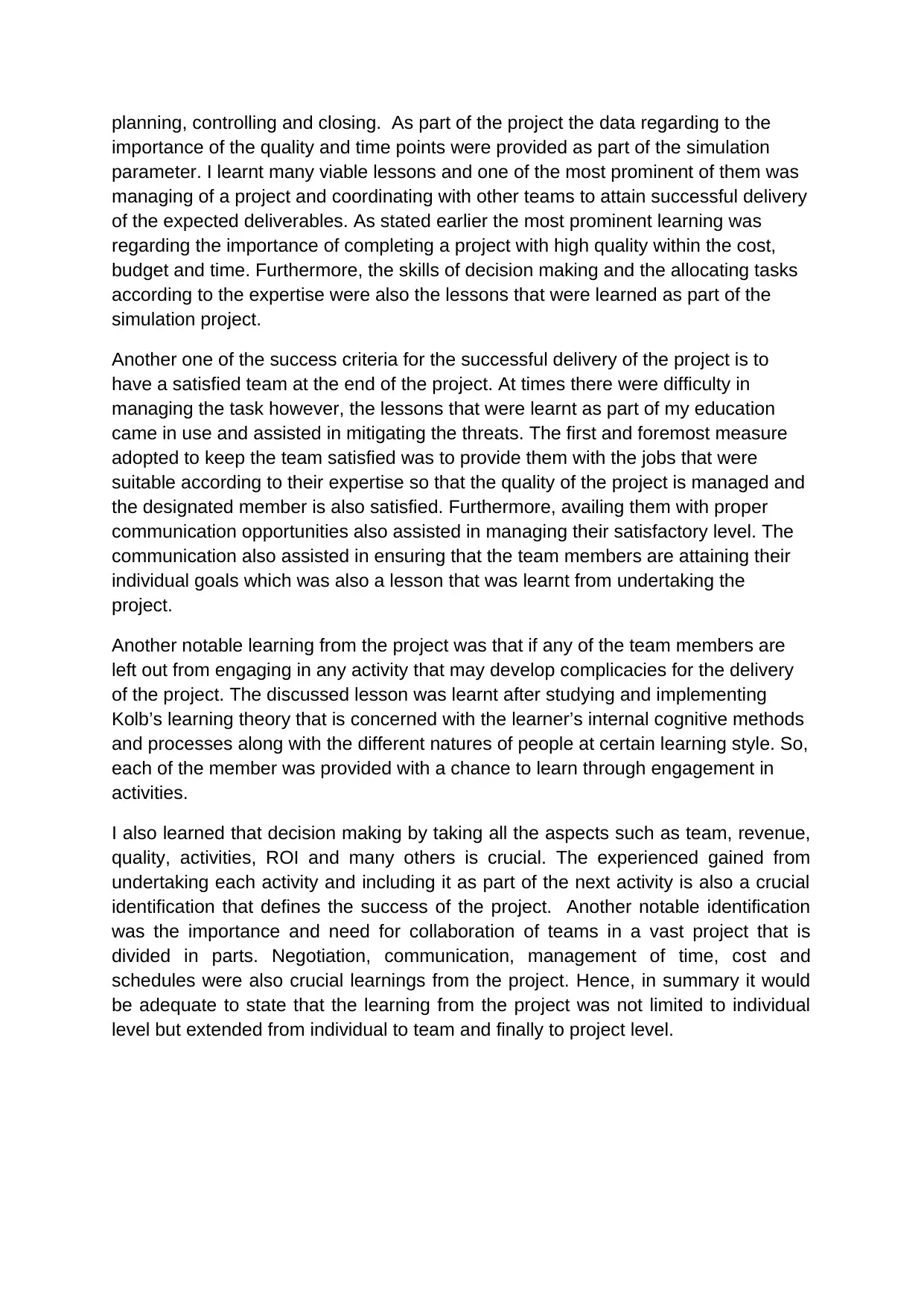
planning, controlling and closing. As part of the project the data regarding to the
importance of the quality and time points were provided as part of the simulation
parameter. I learnt many viable lessons and one of the most prominent of them was
managing of a project and coordinating with other teams to attain successful delivery
of the expected deliverables. As stated earlier the most prominent learning was
regarding the importance of completing a project with high quality within the cost,
budget and time. Furthermore, the skills of decision making and the allocating tasks
according to the expertise were also the lessons that were learned as part of the
simulation project.
Another one of the success criteria for the successful delivery of the project is to
have a satisfied team at the end of the project. At times there were difficulty in
managing the task however, the lessons that were learnt as part of my education
came in use and assisted in mitigating the threats. The first and foremost measure
adopted to keep the team satisfied was to provide them with the jobs that were
suitable according to their expertise so that the quality of the project is managed and
the designated member is also satisfied. Furthermore, availing them with proper
communication opportunities also assisted in managing their satisfactory level. The
communication also assisted in ensuring that the team members are attaining their
individual goals which was also a lesson that was learnt from undertaking the
project.
Another notable learning from the project was that if any of the team members are
left out from engaging in any activity that may develop complicacies for the delivery
of the project. The discussed lesson was learnt after studying and implementing
Kolb’s learning theory that is concerned with the learner’s internal cognitive methods
and processes along with the different natures of people at certain learning style. So,
each of the member was provided with a chance to learn through engagement in
activities.
I also learned that decision making by taking all the aspects such as team, revenue,
quality, activities, ROI and many others is crucial. The experienced gained from
undertaking each activity and including it as part of the next activity is also a crucial
identification that defines the success of the project. Another notable identification
was the importance and need for collaboration of teams in a vast project that is
divided in parts. Negotiation, communication, management of time, cost and
schedules were also crucial learnings from the project. Hence, in summary it would
be adequate to state that the learning from the project was not limited to individual
level but extended from individual to team and finally to project level.
importance of the quality and time points were provided as part of the simulation
parameter. I learnt many viable lessons and one of the most prominent of them was
managing of a project and coordinating with other teams to attain successful delivery
of the expected deliverables. As stated earlier the most prominent learning was
regarding the importance of completing a project with high quality within the cost,
budget and time. Furthermore, the skills of decision making and the allocating tasks
according to the expertise were also the lessons that were learned as part of the
simulation project.
Another one of the success criteria for the successful delivery of the project is to
have a satisfied team at the end of the project. At times there were difficulty in
managing the task however, the lessons that were learnt as part of my education
came in use and assisted in mitigating the threats. The first and foremost measure
adopted to keep the team satisfied was to provide them with the jobs that were
suitable according to their expertise so that the quality of the project is managed and
the designated member is also satisfied. Furthermore, availing them with proper
communication opportunities also assisted in managing their satisfactory level. The
communication also assisted in ensuring that the team members are attaining their
individual goals which was also a lesson that was learnt from undertaking the
project.
Another notable learning from the project was that if any of the team members are
left out from engaging in any activity that may develop complicacies for the delivery
of the project. The discussed lesson was learnt after studying and implementing
Kolb’s learning theory that is concerned with the learner’s internal cognitive methods
and processes along with the different natures of people at certain learning style. So,
each of the member was provided with a chance to learn through engagement in
activities.
I also learned that decision making by taking all the aspects such as team, revenue,
quality, activities, ROI and many others is crucial. The experienced gained from
undertaking each activity and including it as part of the next activity is also a crucial
identification that defines the success of the project. Another notable identification
was the importance and need for collaboration of teams in a vast project that is
divided in parts. Negotiation, communication, management of time, cost and
schedules were also crucial learnings from the project. Hence, in summary it would
be adequate to state that the learning from the project was not limited to individual
level but extended from individual to team and finally to project level.
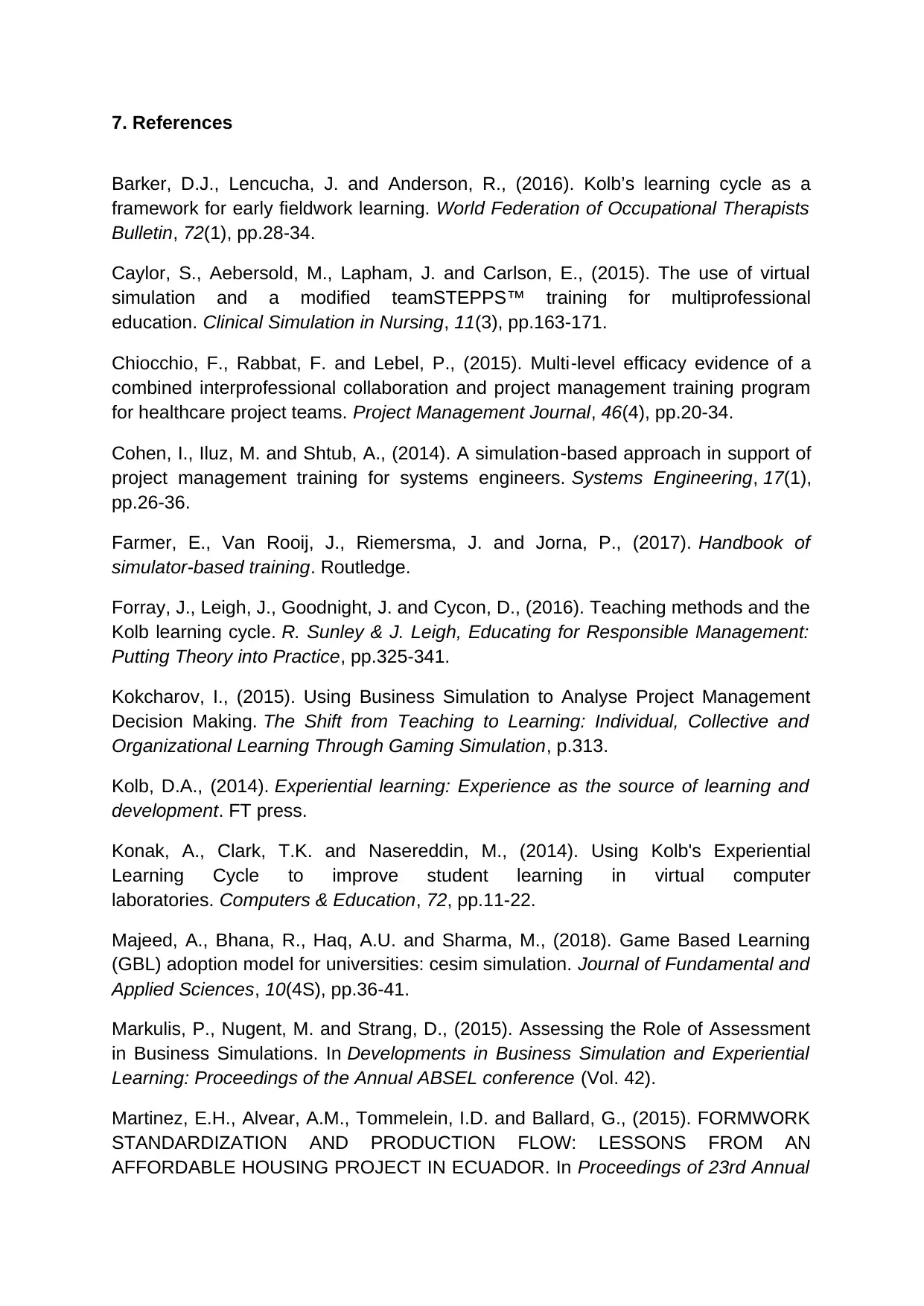
7. References
Barker, D.J., Lencucha, J. and Anderson, R., (2016). Kolb’s learning cycle as a
framework for early fieldwork learning. World Federation of Occupational Therapists
Bulletin, 72(1), pp.28-34.
Caylor, S., Aebersold, M., Lapham, J. and Carlson, E., (2015). The use of virtual
simulation and a modified teamSTEPPS™ training for multiprofessional
education. Clinical Simulation in Nursing, 11(3), pp.163-171.
Chiocchio, F., Rabbat, F. and Lebel, P., (2015). Multi‐level efficacy evidence of a
combined interprofessional collaboration and project management training program
for healthcare project teams. Project Management Journal, 46(4), pp.20-34.
Cohen, I., Iluz, M. and Shtub, A., (2014). A simulation‐based approach in support of
project management training for systems engineers. Systems Engineering, 17(1),
pp.26-36.
Farmer, E., Van Rooij, J., Riemersma, J. and Jorna, P., (2017). Handbook of
simulator-based training. Routledge.
Forray, J., Leigh, J., Goodnight, J. and Cycon, D., (2016). Teaching methods and the
Kolb learning cycle. R. Sunley & J. Leigh, Educating for Responsible Management:
Putting Theory into Practice, pp.325-341.
Kokcharov, I., (2015). Using Business Simulation to Analyse Project Management
Decision Making. The Shift from Teaching to Learning: Individual, Collective and
Organizational Learning Through Gaming Simulation, p.313.
Kolb, D.A., (2014). Experiential learning: Experience as the source of learning and
development. FT press.
Konak, A., Clark, T.K. and Nasereddin, M., (2014). Using Kolb's Experiential
Learning Cycle to improve student learning in virtual computer
laboratories. Computers & Education, 72, pp.11-22.
Majeed, A., Bhana, R., Haq, A.U. and Sharma, M., (2018). Game Based Learning
(GBL) adoption model for universities: cesim simulation. Journal of Fundamental and
Applied Sciences, 10(4S), pp.36-41.
Markulis, P., Nugent, M. and Strang, D., (2015). Assessing the Role of Assessment
in Business Simulations. In Developments in Business Simulation and Experiential
Learning: Proceedings of the Annual ABSEL conference (Vol. 42).
Martinez, E.H., Alvear, A.M., Tommelein, I.D. and Ballard, G., (2015). FORMWORK
STANDARDIZATION AND PRODUCTION FLOW: LESSONS FROM AN
AFFORDABLE HOUSING PROJECT IN ECUADOR. In Proceedings of 23rd Annual
Barker, D.J., Lencucha, J. and Anderson, R., (2016). Kolb’s learning cycle as a
framework for early fieldwork learning. World Federation of Occupational Therapists
Bulletin, 72(1), pp.28-34.
Caylor, S., Aebersold, M., Lapham, J. and Carlson, E., (2015). The use of virtual
simulation and a modified teamSTEPPS™ training for multiprofessional
education. Clinical Simulation in Nursing, 11(3), pp.163-171.
Chiocchio, F., Rabbat, F. and Lebel, P., (2015). Multi‐level efficacy evidence of a
combined interprofessional collaboration and project management training program
for healthcare project teams. Project Management Journal, 46(4), pp.20-34.
Cohen, I., Iluz, M. and Shtub, A., (2014). A simulation‐based approach in support of
project management training for systems engineers. Systems Engineering, 17(1),
pp.26-36.
Farmer, E., Van Rooij, J., Riemersma, J. and Jorna, P., (2017). Handbook of
simulator-based training. Routledge.
Forray, J., Leigh, J., Goodnight, J. and Cycon, D., (2016). Teaching methods and the
Kolb learning cycle. R. Sunley & J. Leigh, Educating for Responsible Management:
Putting Theory into Practice, pp.325-341.
Kokcharov, I., (2015). Using Business Simulation to Analyse Project Management
Decision Making. The Shift from Teaching to Learning: Individual, Collective and
Organizational Learning Through Gaming Simulation, p.313.
Kolb, D.A., (2014). Experiential learning: Experience as the source of learning and
development. FT press.
Konak, A., Clark, T.K. and Nasereddin, M., (2014). Using Kolb's Experiential
Learning Cycle to improve student learning in virtual computer
laboratories. Computers & Education, 72, pp.11-22.
Majeed, A., Bhana, R., Haq, A.U. and Sharma, M., (2018). Game Based Learning
(GBL) adoption model for universities: cesim simulation. Journal of Fundamental and
Applied Sciences, 10(4S), pp.36-41.
Markulis, P., Nugent, M. and Strang, D., (2015). Assessing the Role of Assessment
in Business Simulations. In Developments in Business Simulation and Experiential
Learning: Proceedings of the Annual ABSEL conference (Vol. 42).
Martinez, E.H., Alvear, A.M., Tommelein, I.D. and Ballard, G., (2015). FORMWORK
STANDARDIZATION AND PRODUCTION FLOW: LESSONS FROM AN
AFFORDABLE HOUSING PROJECT IN ECUADOR. In Proceedings of 23rd Annual
1 out of 16
Related Documents
Your All-in-One AI-Powered Toolkit for Academic Success.
+13062052269
info@desklib.com
Available 24*7 on WhatsApp / Email
![[object Object]](/_next/static/media/star-bottom.7253800d.svg)
Unlock your academic potential
© 2024 | Zucol Services PVT LTD | All rights reserved.